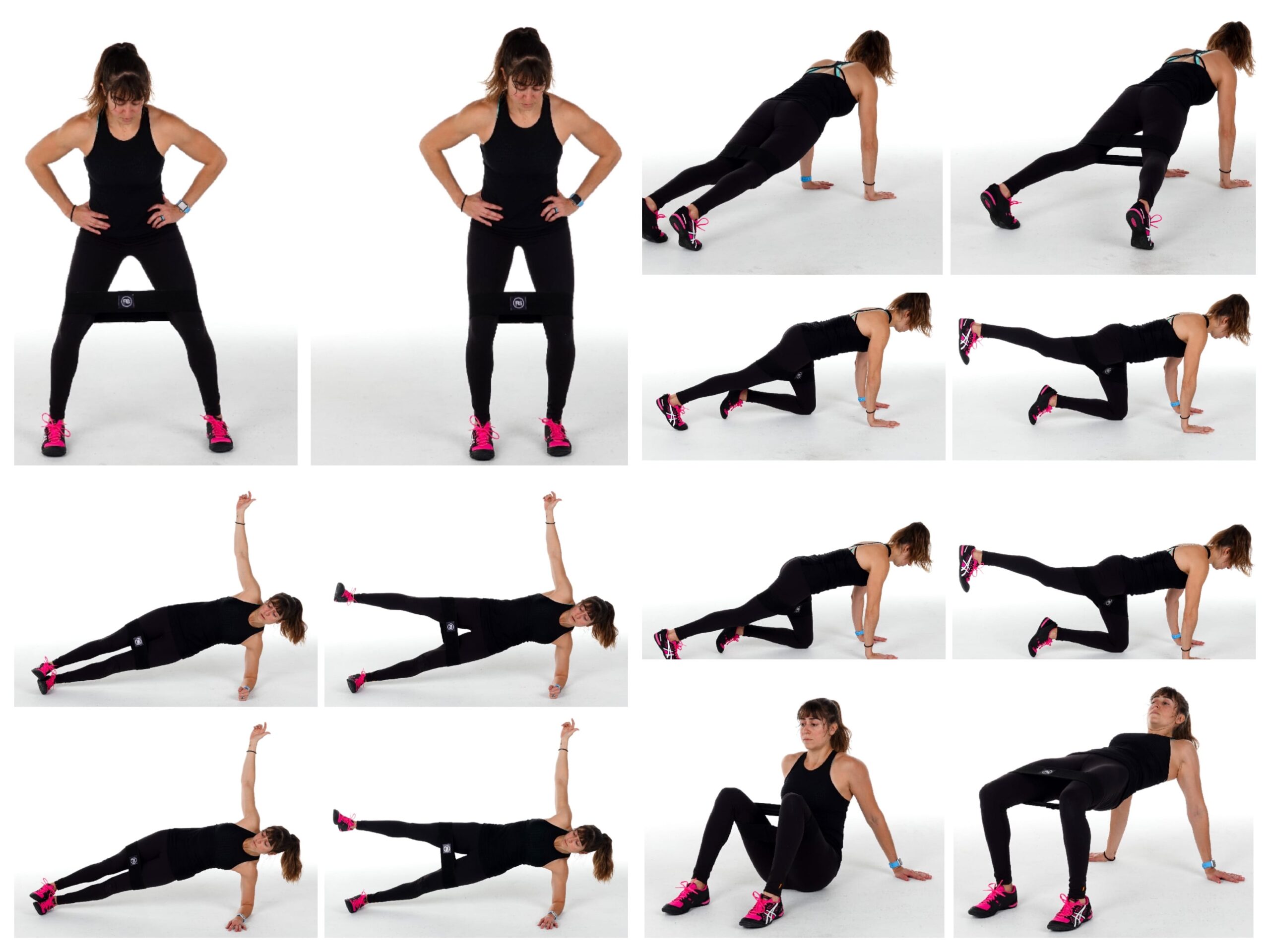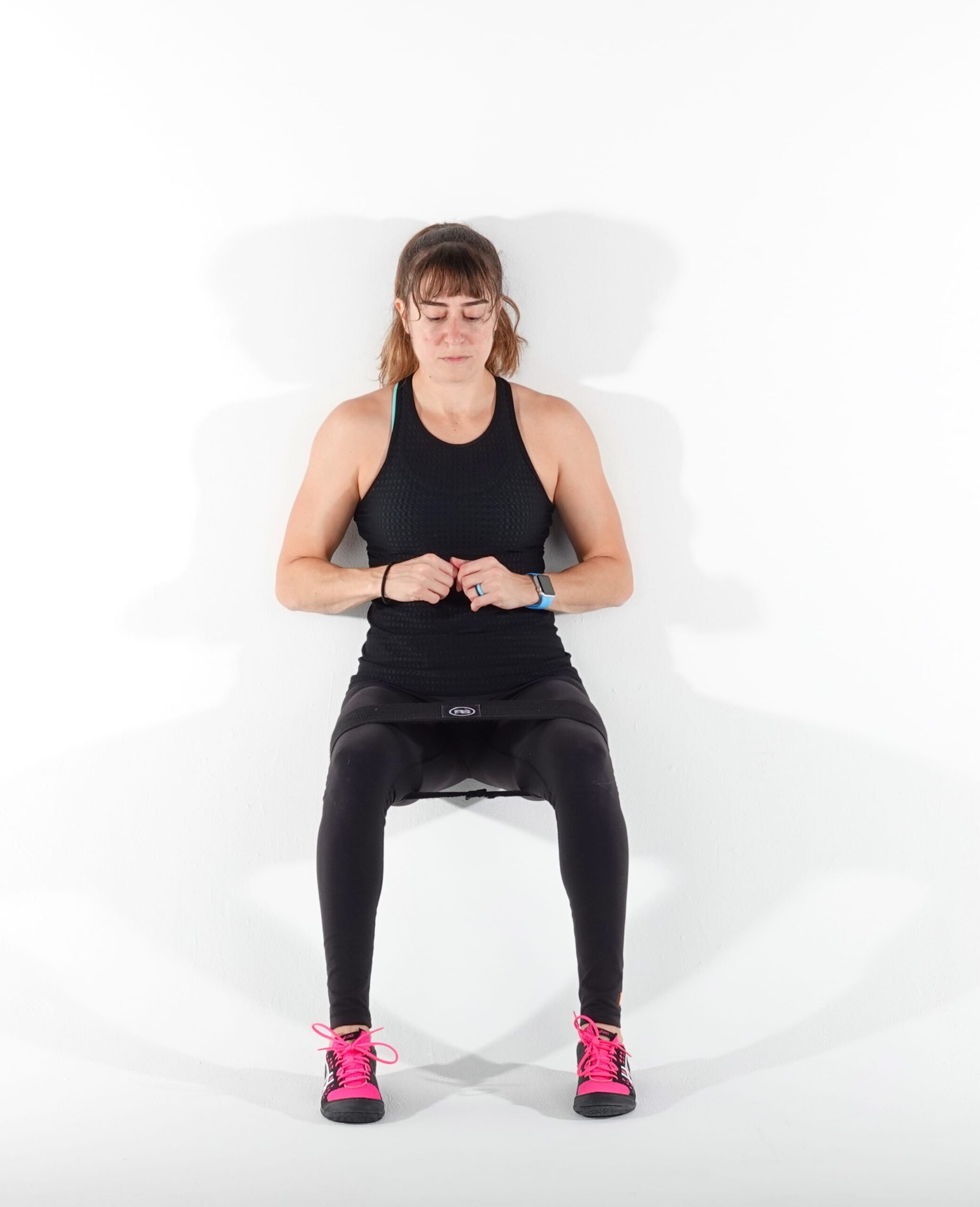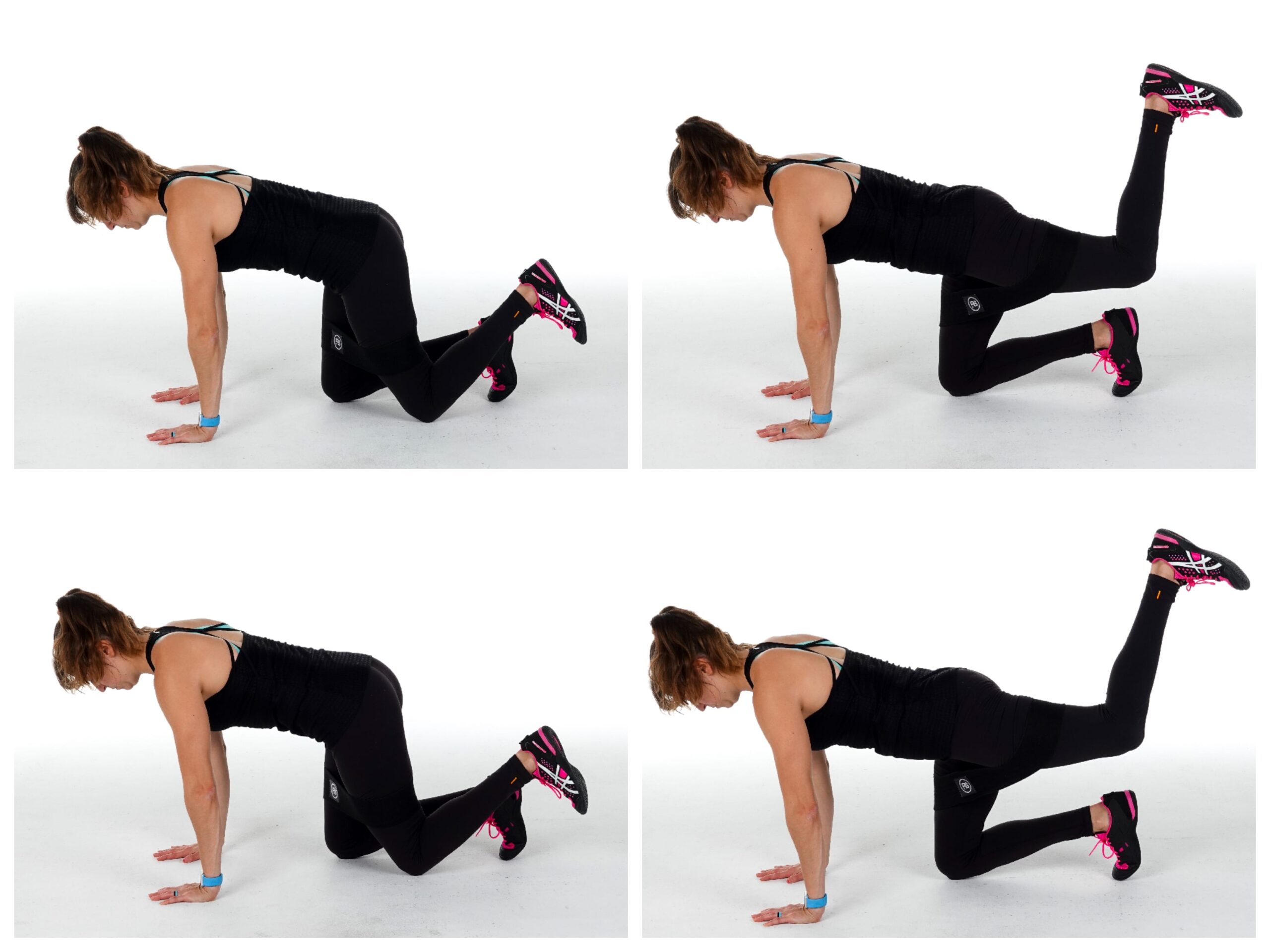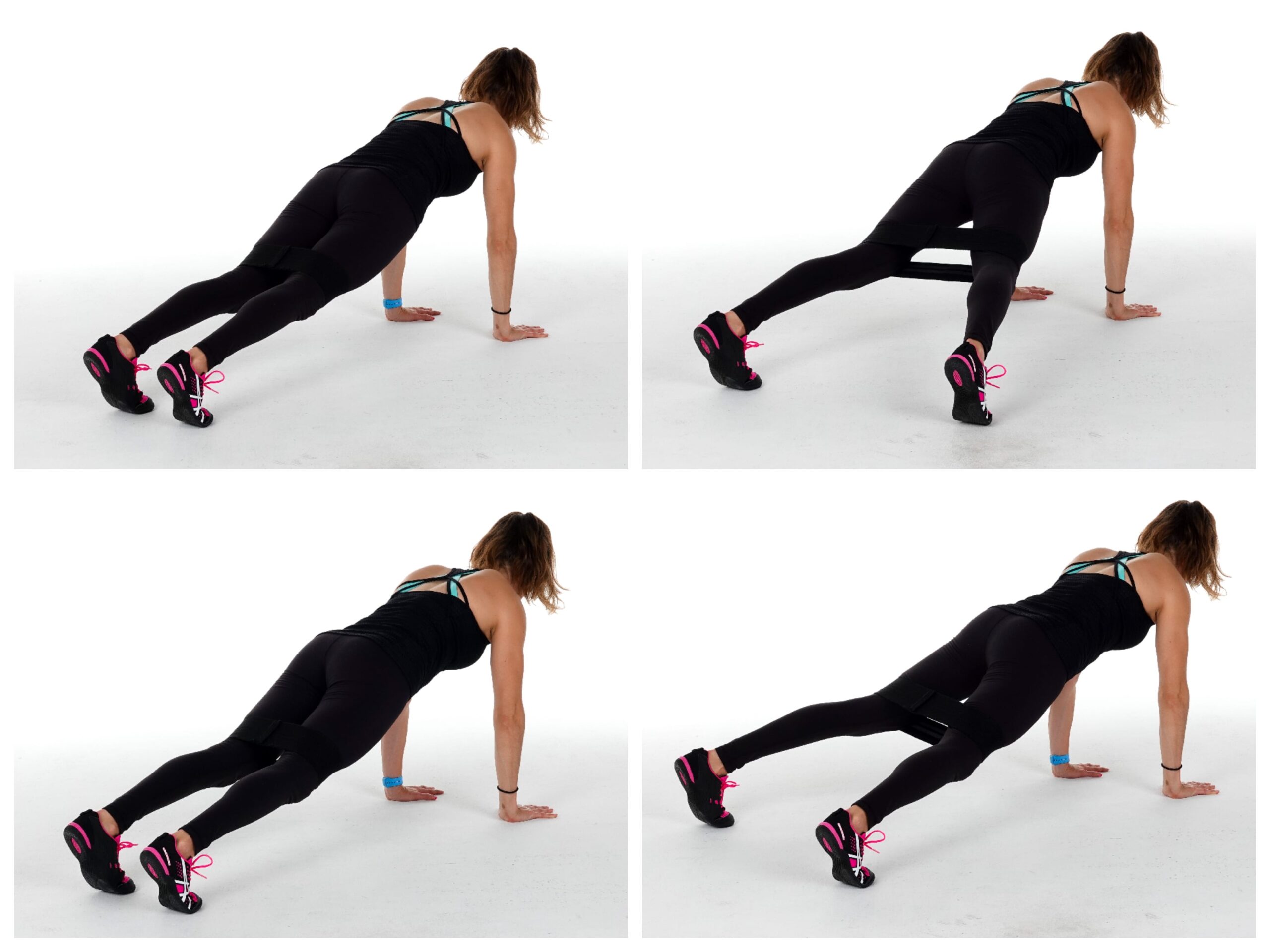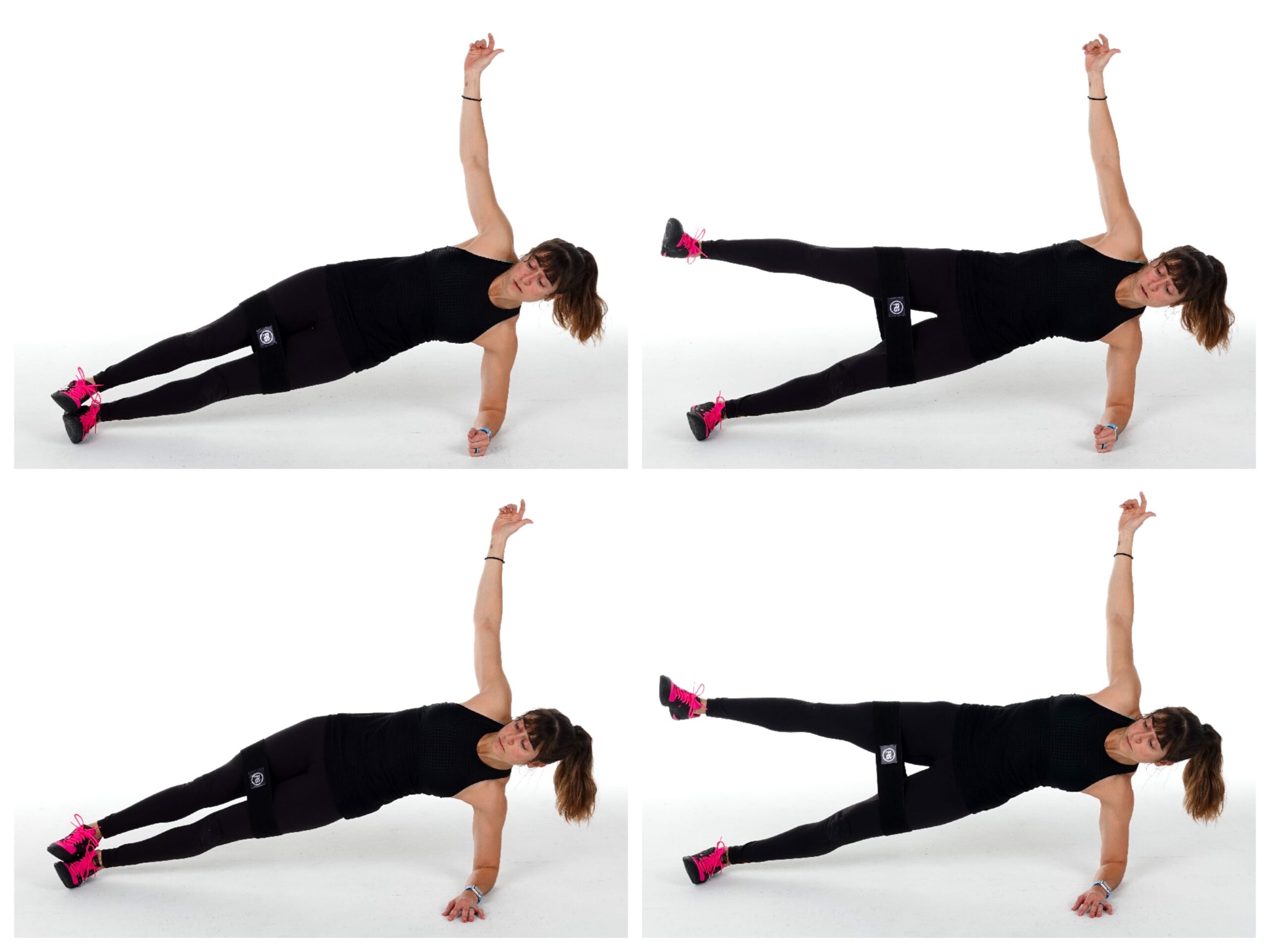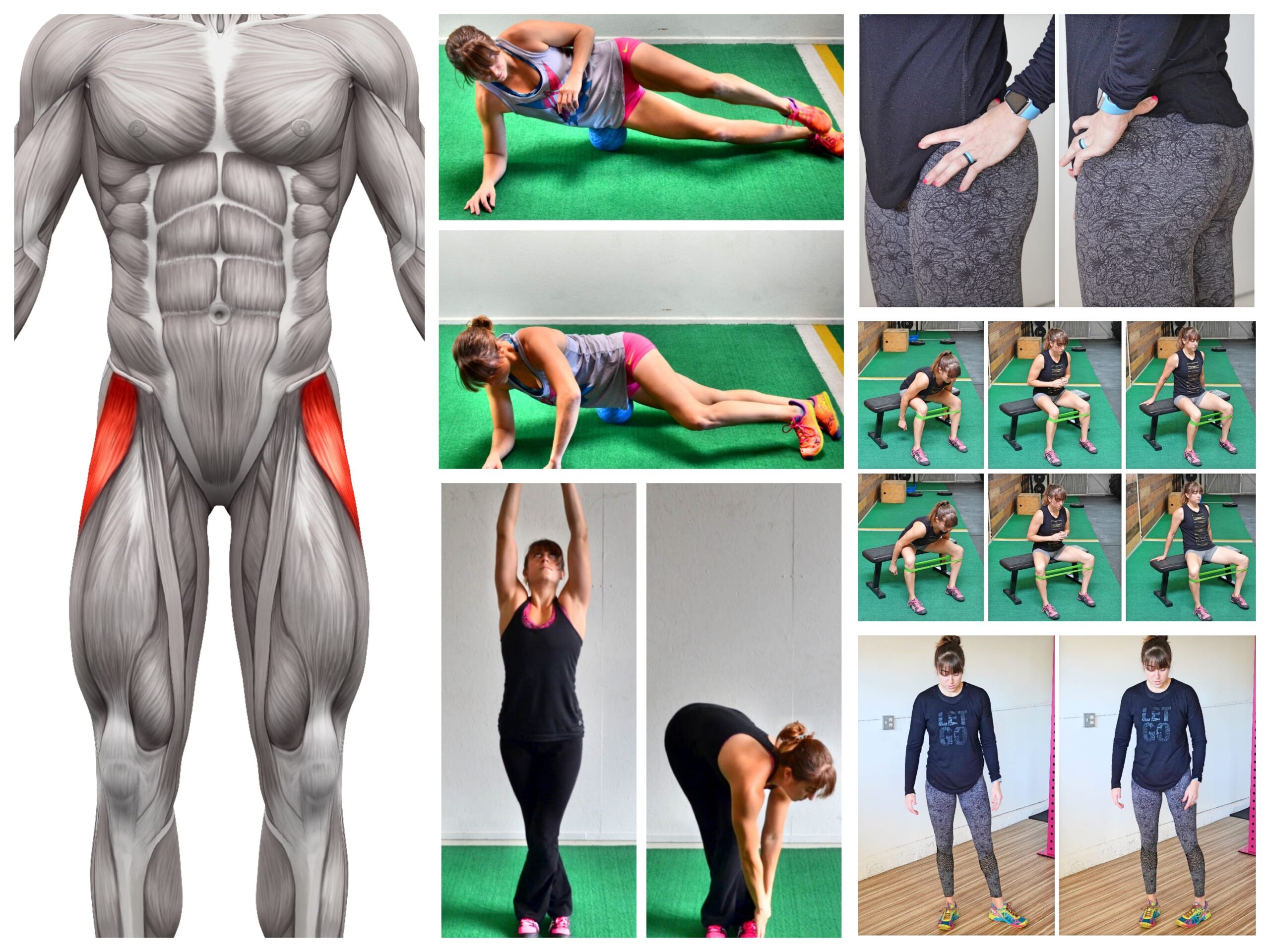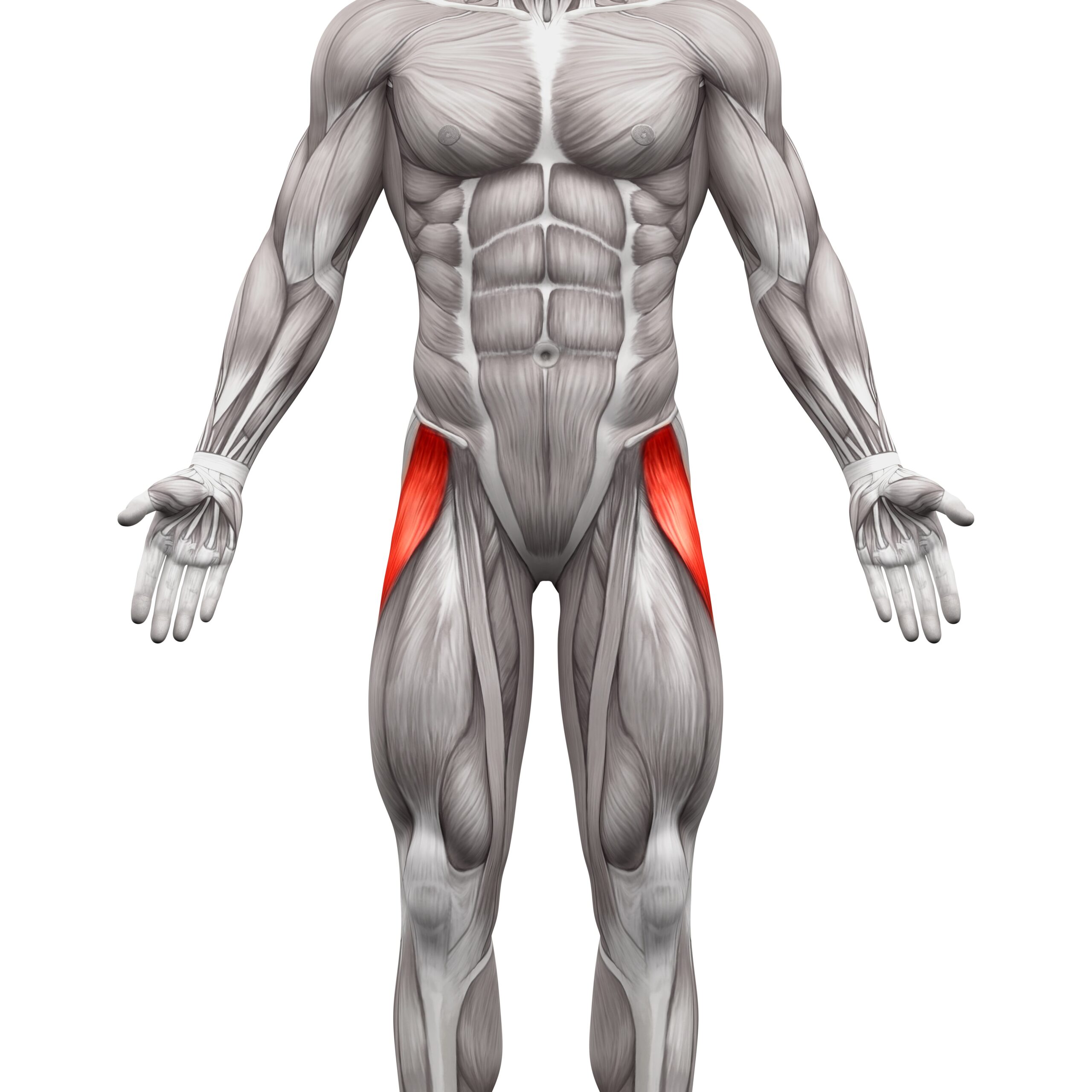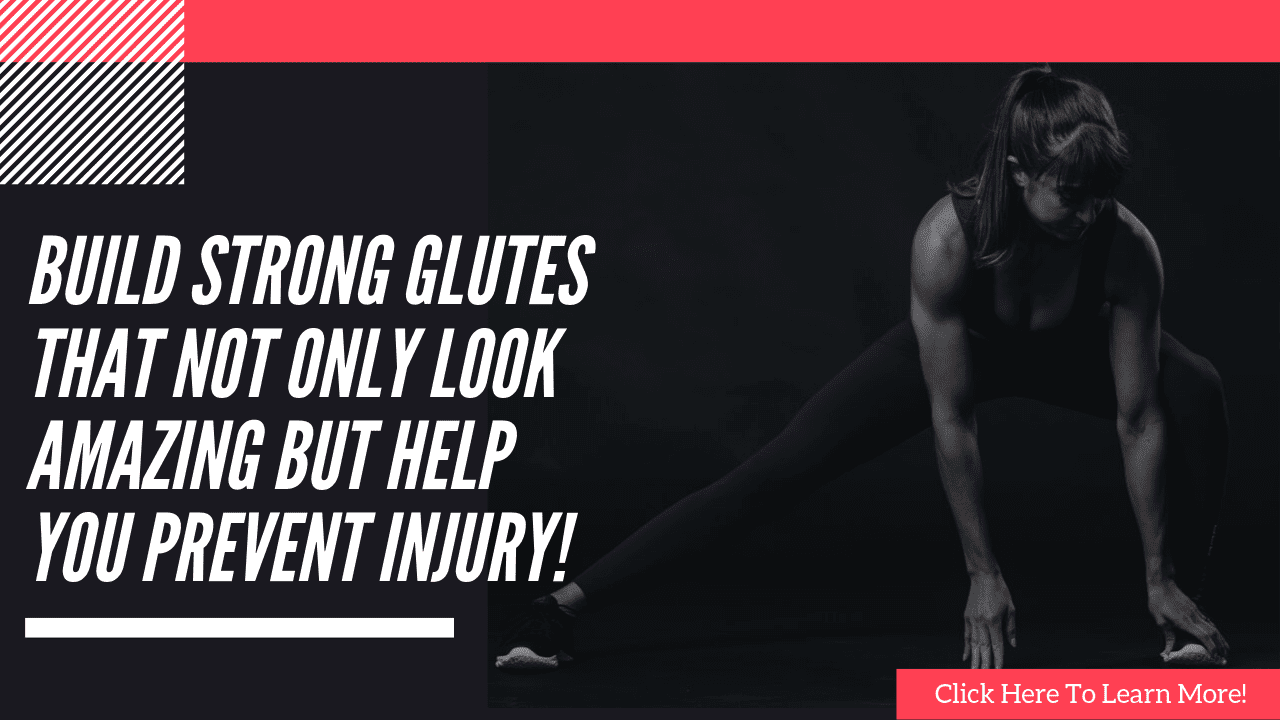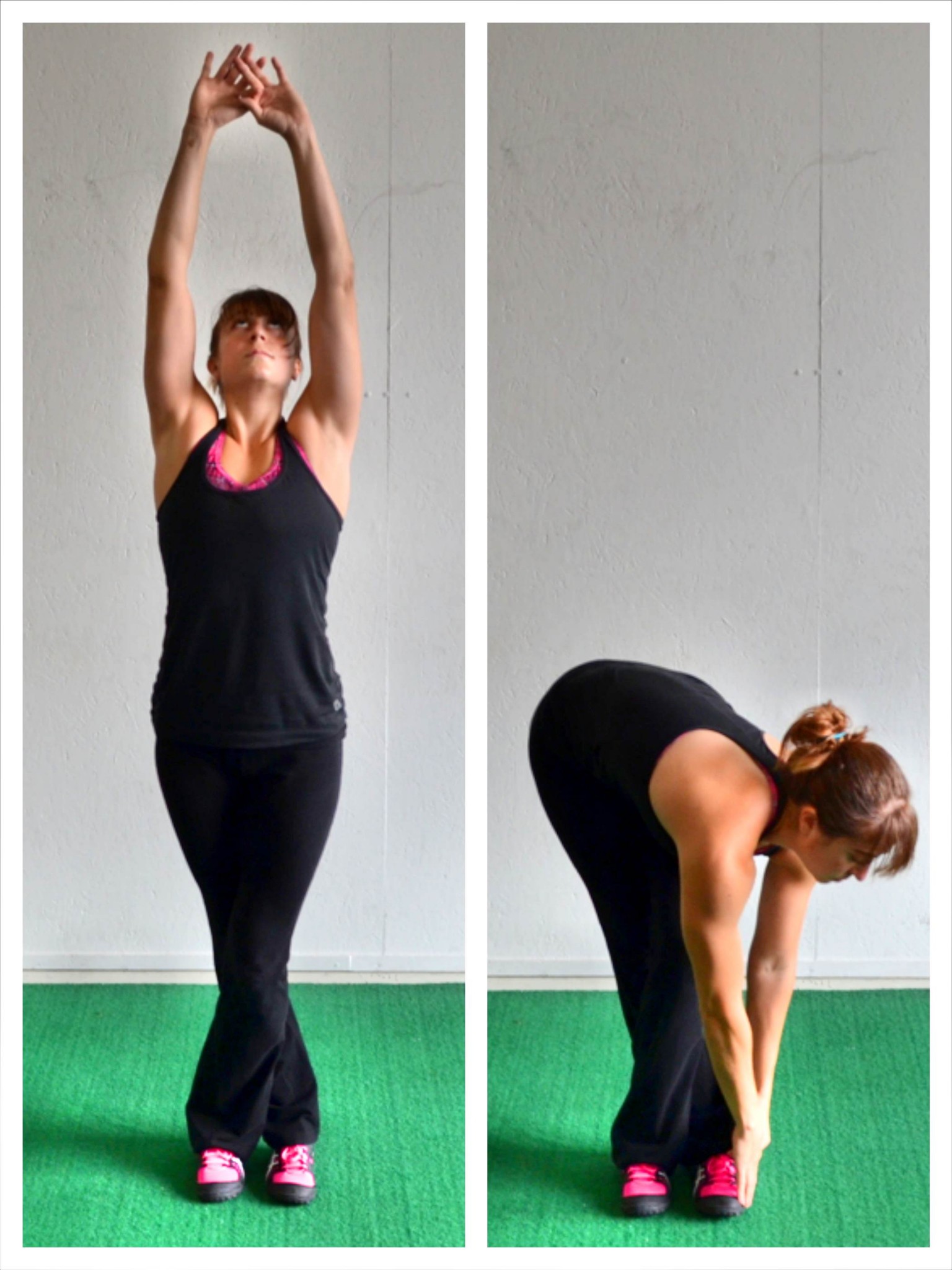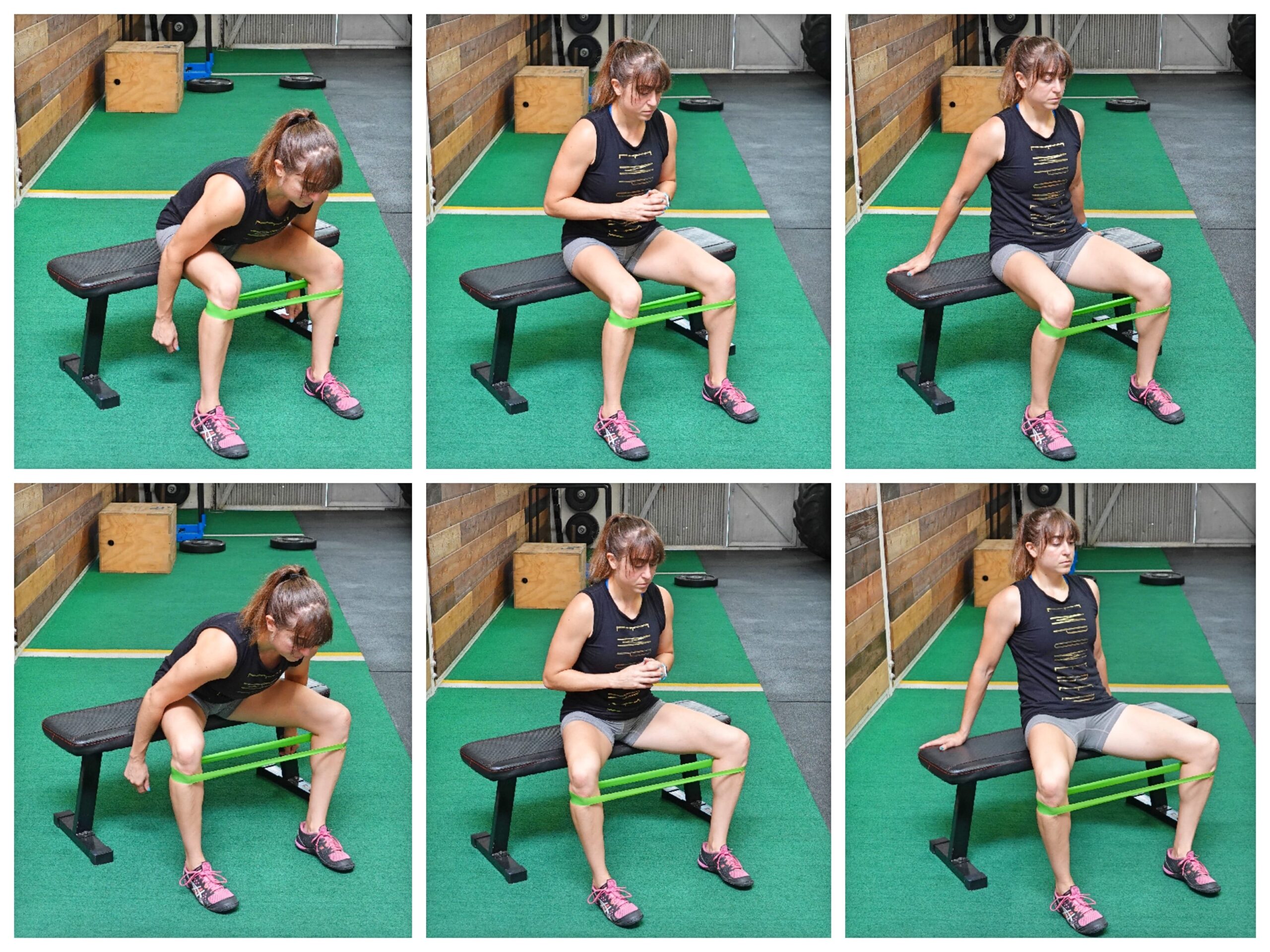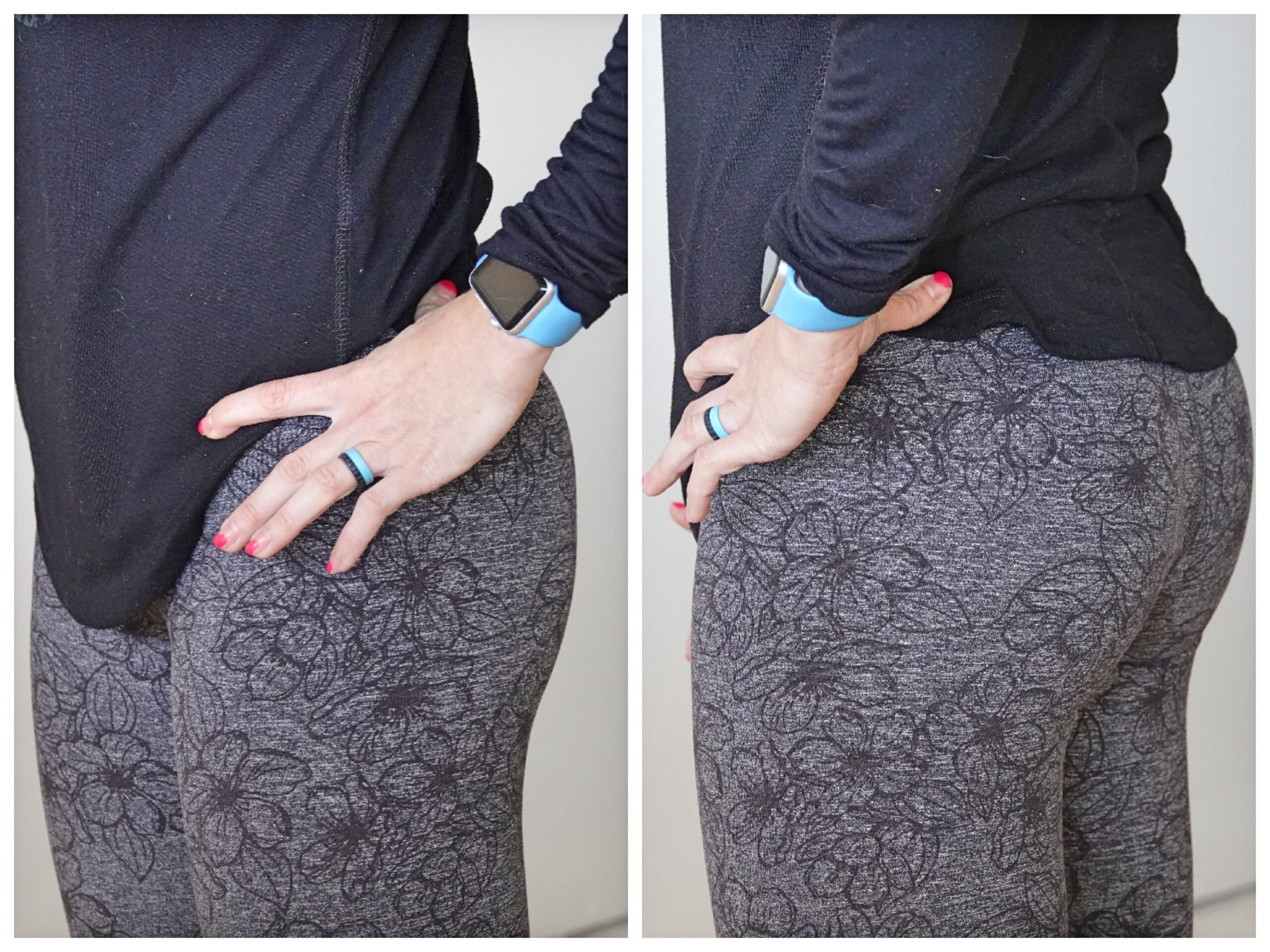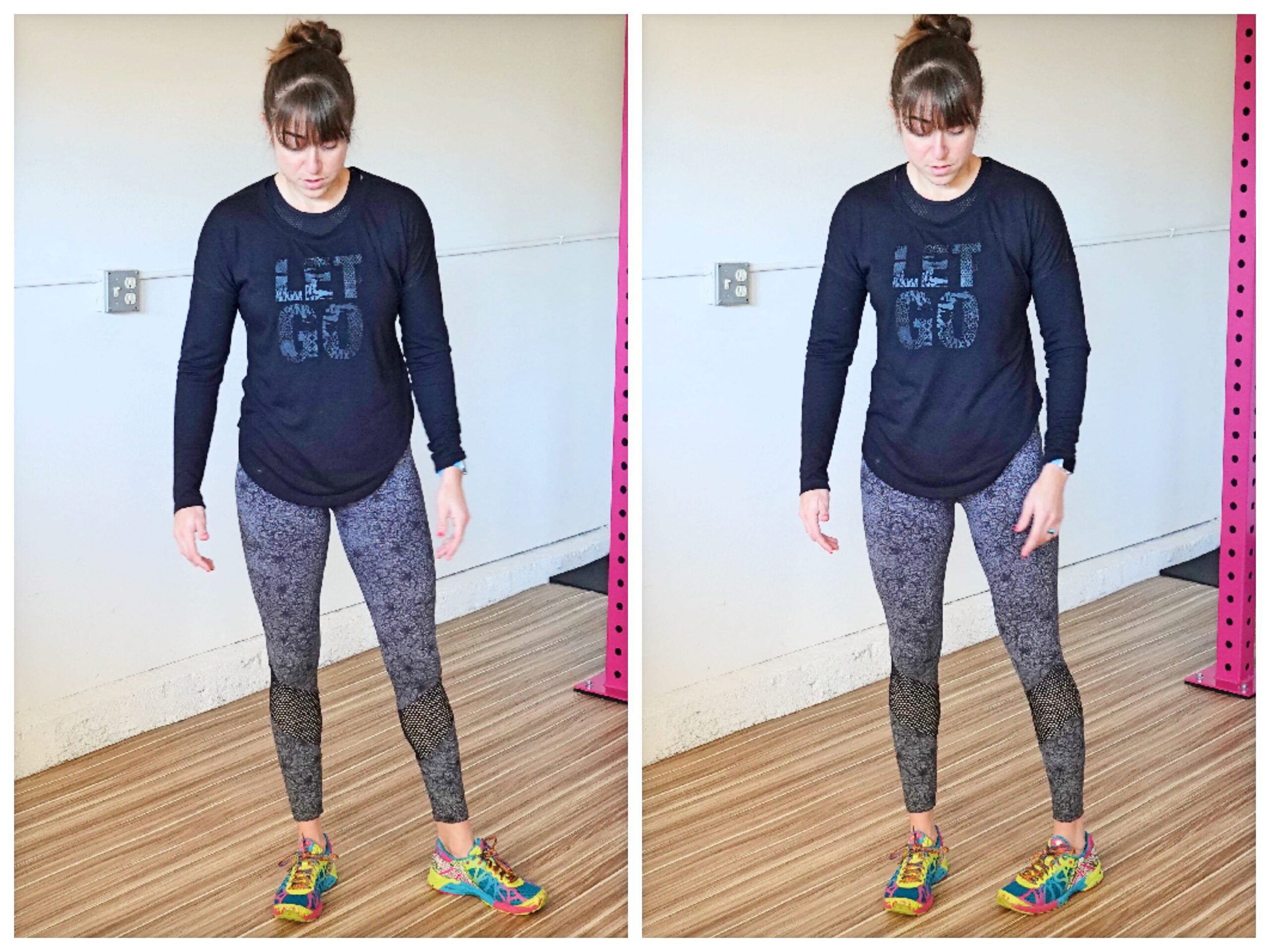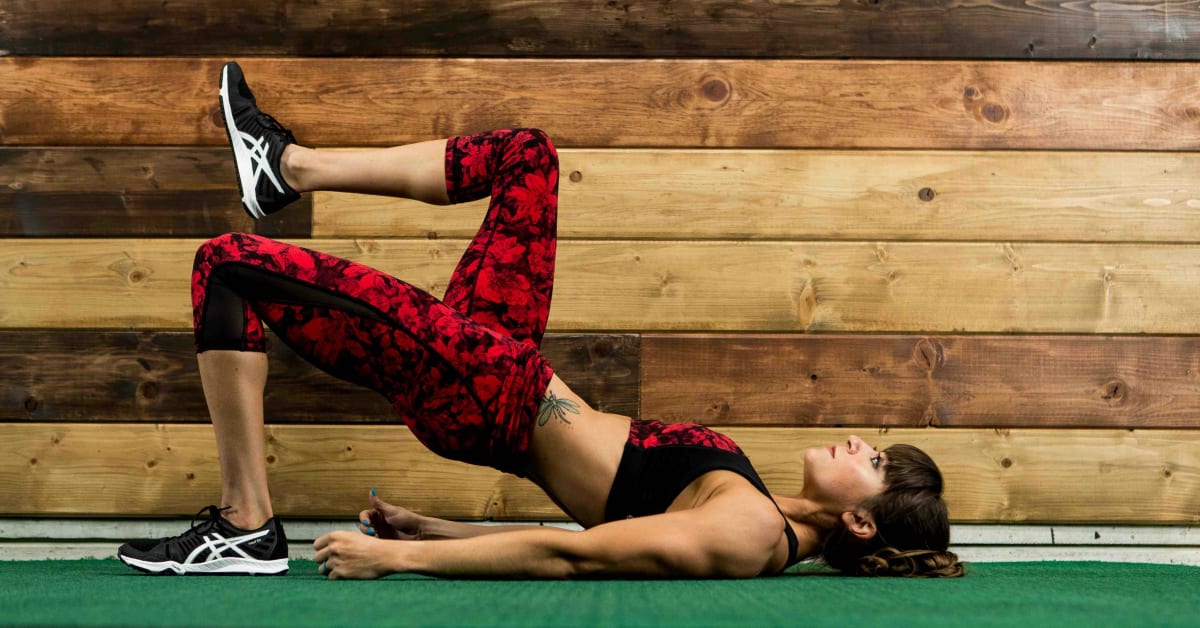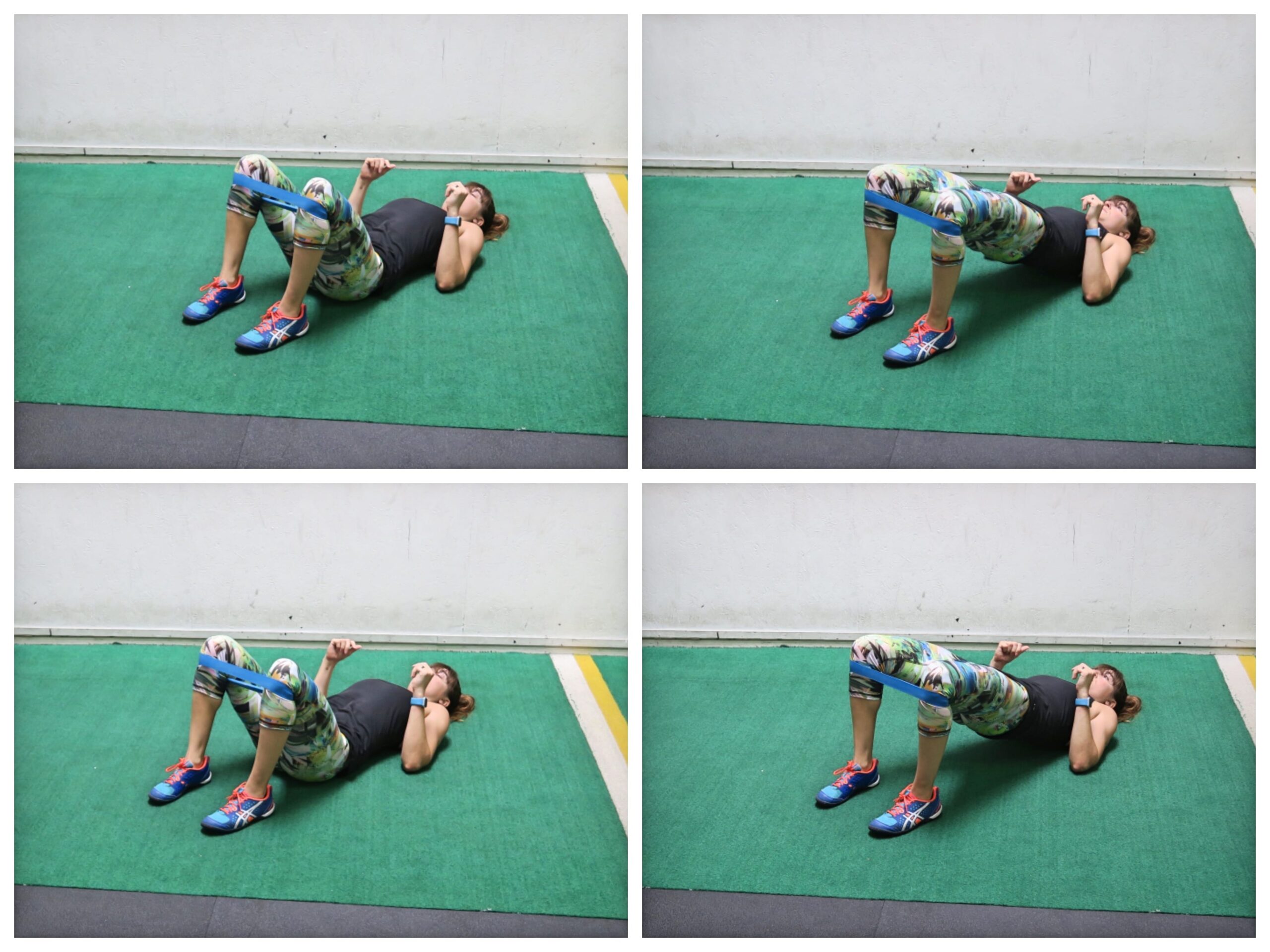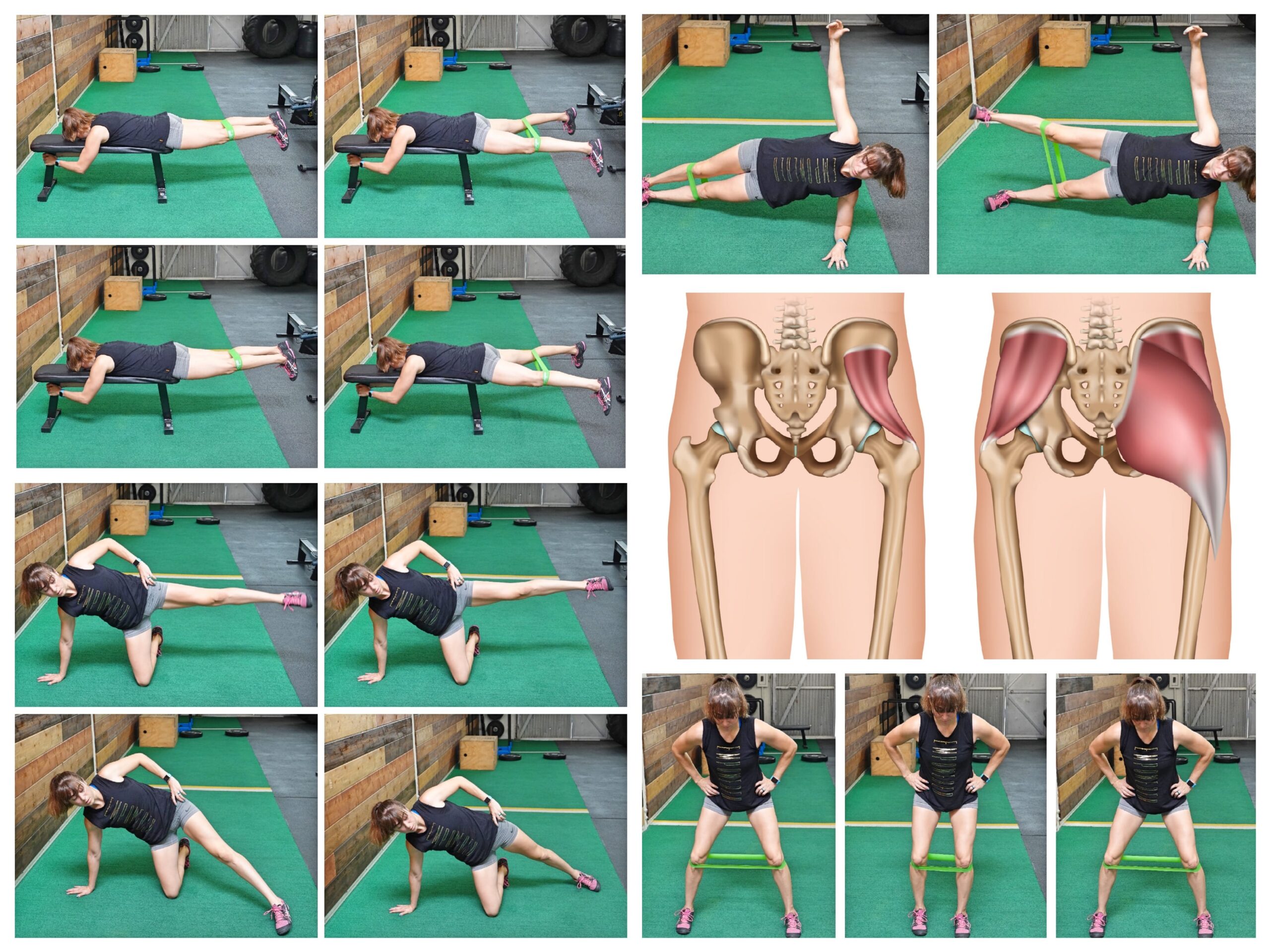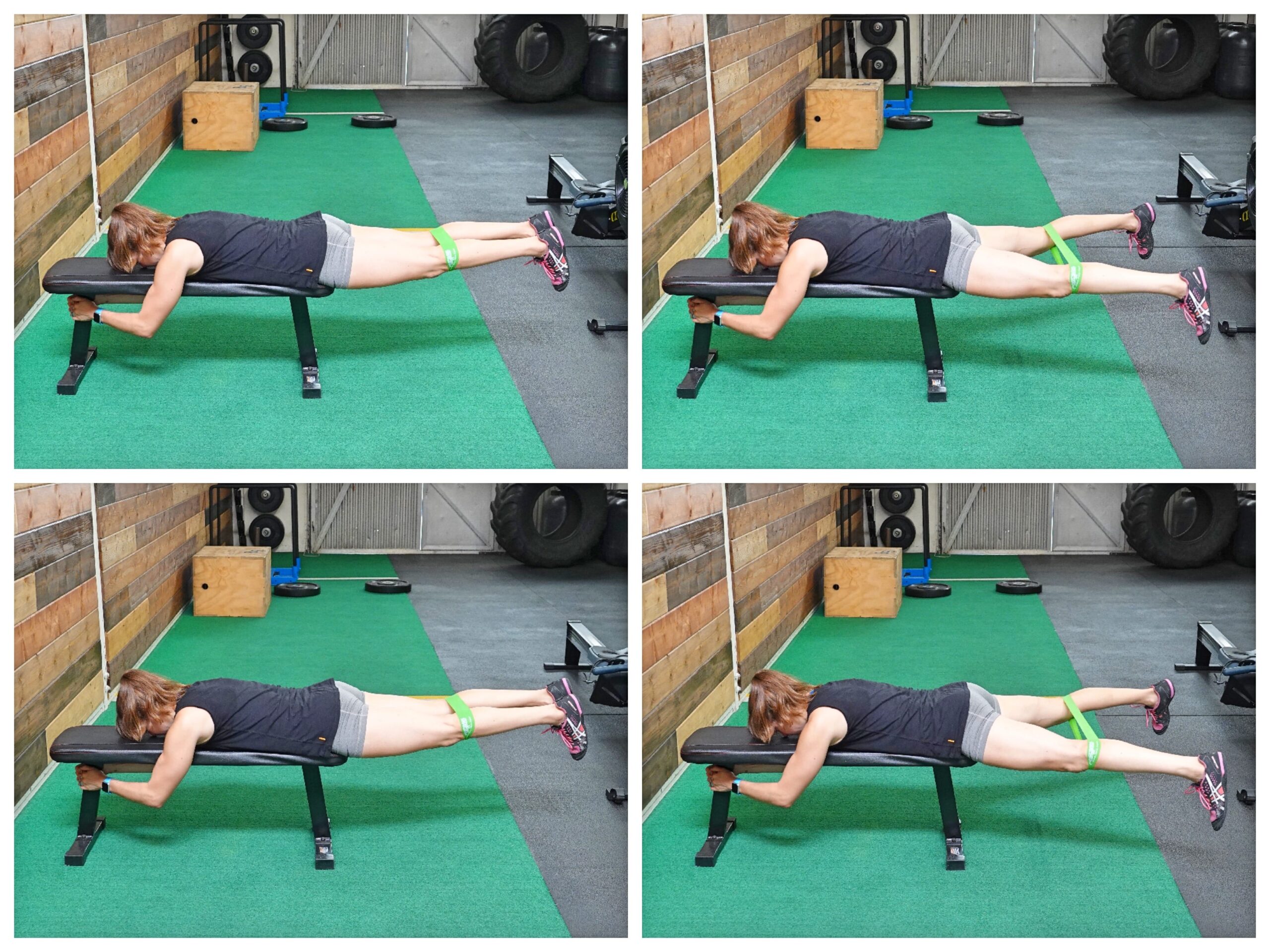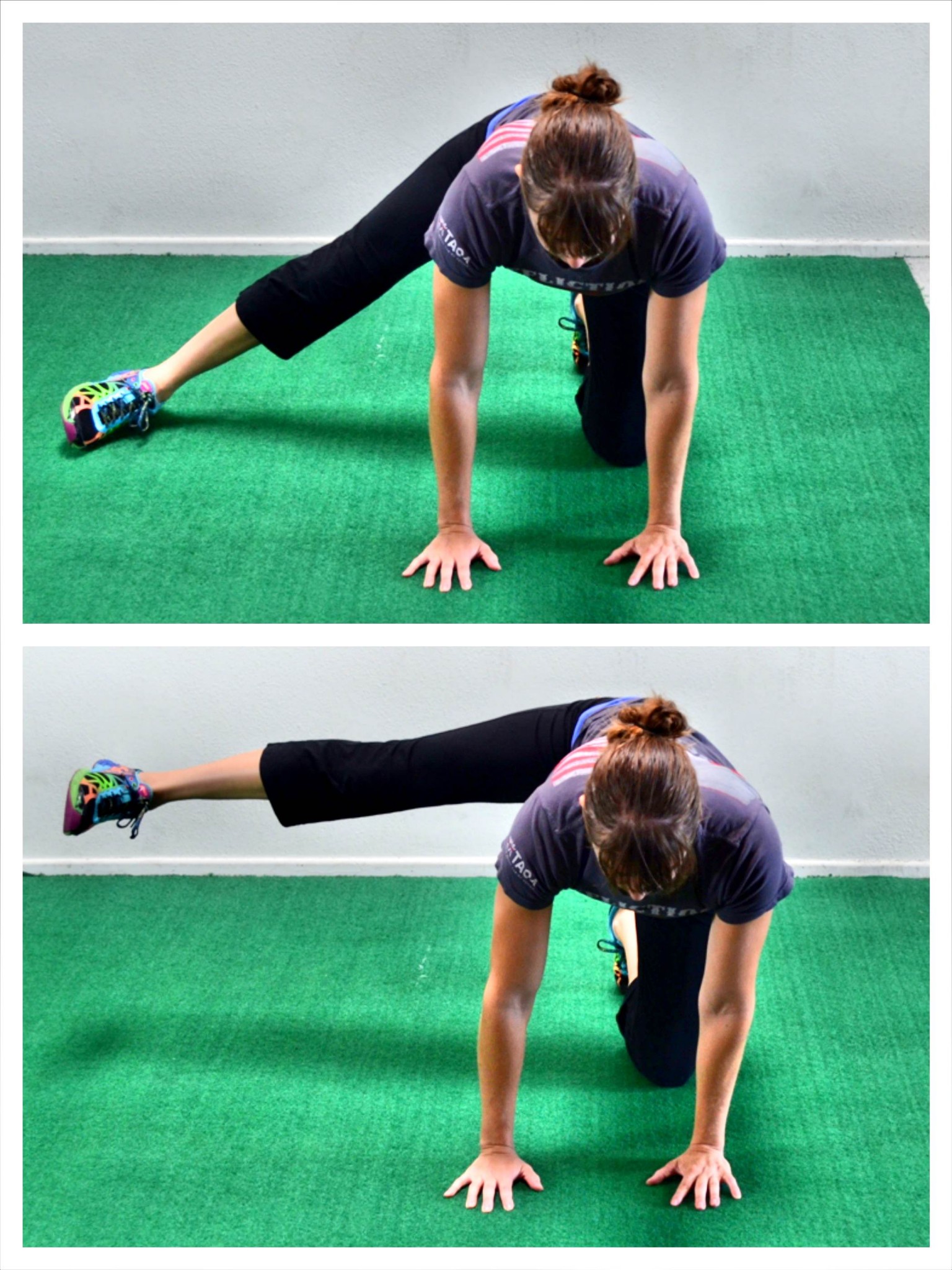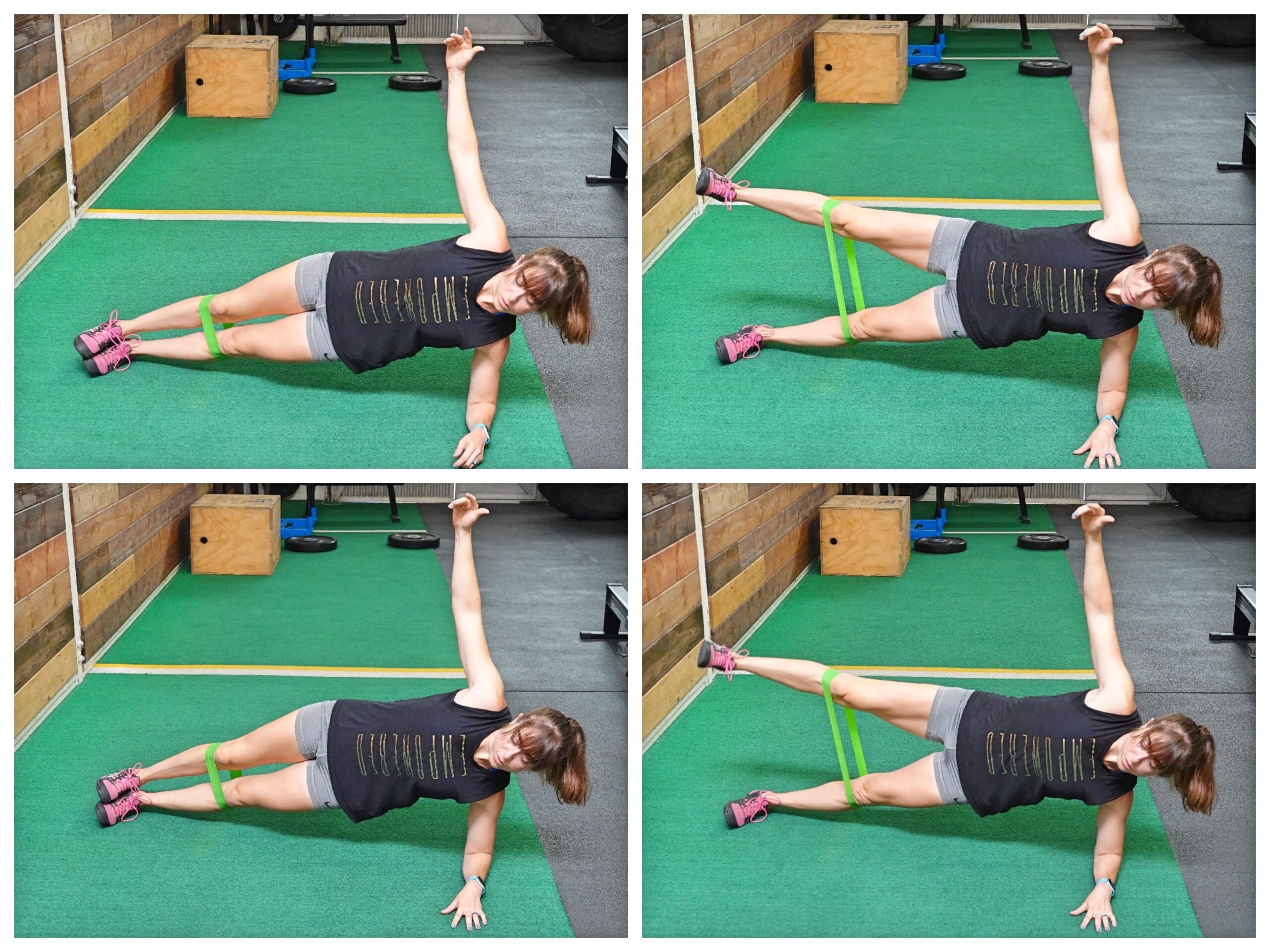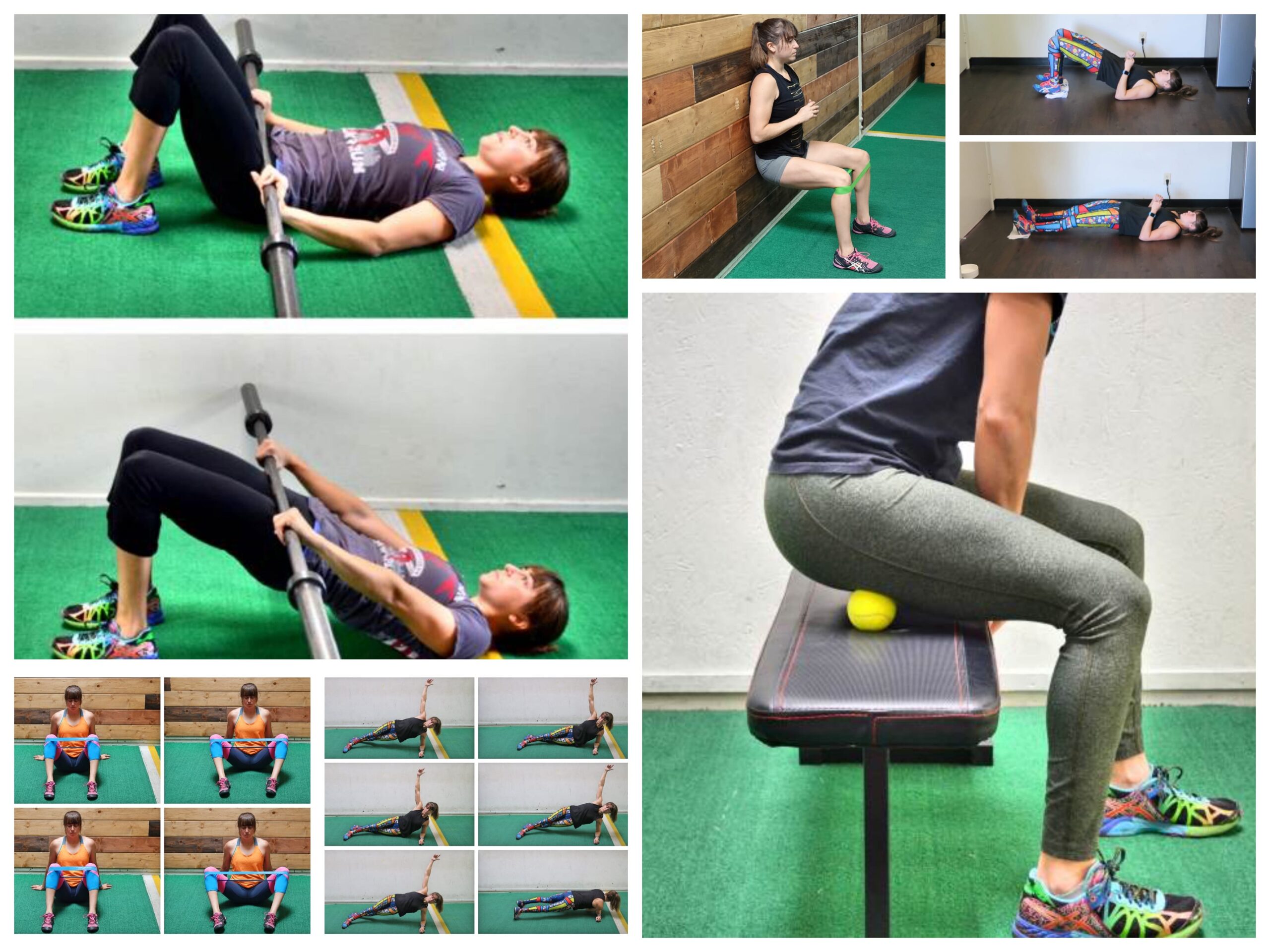
by Cori Lefkowith | Feb 7, 2019 | Blog, Butt, Core, Exercises
Whether you want to prevent lower back, hip, knee or even foot and ankle pain or you want to run faster, cycle further or lift more, you’ve got to get those glutes activated and working efficiently.
And the Booty Band is the perfect tool to help you do just that!
By using a band for these moves, you help yourself engage the glute medius to stabilize your hips and this can, in turn, help the glute maximus also fire better and become stronger.
The band is great too because it applies constant pressure, even increasing pressure at the point in the movement where you are the strongest.
Because of the nature of the bands, the range of motion on many of these moves and the PUMP the band creates, it really helps you establish that mind-body connection and use metabolic stress to drive muscle growth.
10 Booty Band Moves To Activate Your Glutes
Squat to Squat Pulse:

If you’re planning to include squats in your workout, this is a great way to warm up your muscles, improve your hip mobility and activate your glutes.
To do the Squat to Squat Pulse, place the Booty Band right above your knees and stand with your feet about hip-width to shoulder-width apart.
Then squat down, sitting your butt down and back. Press out on the band as you squat to about parallel or below. Do not let your knees cave in as you lower down.
Drive back up to standing and make sure you press out against the band as you stand back up. Do not let your knees cave as you stand up. Also, make sure you aren’t rocking in on your feet. After standing back up, squat down again.
This time at the bottom, come up only a few inches to pulse up and then sink back down before standing all the way back up.
Throughout, really focus on pressing out on that band!
Repeat, performing the squat then the pulse at the bottom before another full squat.
Wall Sit:

If you’ve ever had knee pain, or if you’re an avid skier, runner or cyclist, the Booty Band Wall Sit is a must-do move!
To do the Booty Band Wall Sit, place a booty band right above your knees.
Then sit back against a wall with your feet about hip-width to shoulder-width apart and your knees over your ankles. Make sure your hips, knees and feet are all in line. Don’t let the band cause your knees to cave in. Press out against the band as you stay in that wall sit with your knees and hips about at 90 degrees.
Do not drop down below that parallel squat. Beginners may be up a bit higher if needed, but try to get your quads to about parallel to the ground. Hold here and think about what you feel working. And press your back into the wall, driving through your heels.
Donkey Kicks:

Correct imbalances as you activate your glutes with this unilateral move. It is also a great way to work on engaging your and activating your abs!
To do Booty Band Donkey Kick, start on your hands and knees and place a band right above your knees. You’ll be in a quadruped position with the band around your legs.
Your knees should be right under your hips and your feet should be flexed. Make sure your hands are right under your shoulders.
Then keeping one knee bent and foot flexed, drive that foot up and back toward the ceiling. Keep your core braced and squeeze your glute as you kick your heel up and back. Do not let your right knee flare out as you lift; however, you can kick slightly up and out to create more lateral tension on the band.
Make sure to really drive your heel up toward the ceiling. Extend your hip as you kick back. Don’t simply swing the leg back and up or hyperextend your low back to kick up higher. You want to squeeze your glute and feel your hip extending. Do not worry so much about height but about contracting your glute to almost “stop” yourself from kicking higher.
Hold for a second then lower back down and repeat.
You can also make it even more of a burner by pulsing at that end range of motion or create a bit more muscle tension by working through a fuller range of motion. You can also go down to your forearms if you find you want to arch your back or have wrist pain.
3-Way Seated Abductions:

Strengthen your glute medius from 3 different positions to activate both anterior and posterior fibers! Sometimes it isn’t about using a heavier resistance to create change, but about simply tweaks to your body position.
To do 3-Way Seated Booty Band Abductions, place the band right above your knees and sit on a bench. Start by sitting toward the front of the bench so you can lean back and put your hands on the bench behind you. Place your feet about hip-width apart.
Then press your knees open against the band as you lean back. Your feet may rock open but focus on using your glutes to press the band open with your knees. Do not let your knees cave in as you come back to the starting position. Complete all reps then move to sit up nice and tall.
Sitting nice and tall repeat, pressing out with your knees so you feel your glutes working. After completing all reps, lean forward and repeat the movement. You can hold on the bench outside your legs to lean forward or just lean over even lightly resting your arms on your legs.
Complete all reps in each of the 3 positions. Make sure you’re really focused on pressing your knees out to feel your glutes while controlling the band back in. To reduce tension, you can put your feet slightly closer together, but make sure there is tension on the band even in that starting position or the band may slip down.
Bridge with Abduction:

This is a great move to work on hip extension while activating your glute medius and maximus.
If you even include a “squeeze” as you bridge up and lower, you can help activate and strengthen your adductors as well, which can be beneficial for anyone with hip or knee pain.
To do the Bridge with Abduction, place the Booty Band right above your knees and lie on your back with your knees bent and feet together and flat on the ground just beyond your finger tips when your arms are stretched down by your sides.
Bend your elbows to 90 degrees and drive your upper arms down into the ground. Squeeze your legs together and even posterior tilt your pelvis, pressing your lower back into the ground.
Then bridge up, driving through your heels. At the top, push your knees out against the band as far apart as you can. Bring your knees back together and squeeze your legs together as you lower down.
Repeat bridging back up. Do not arch your lower back just to bridge up higher. Really feel your glutes working to bridge up then the sides of your butt working to press your knees open. You may even feel your inner thighs working as you lift and lower.
The band may lose tension as you squeeze your legs together but should become tight as you fully press to abduct at the top.
Alternating Side Taps:

This is a great abduction or lateral move to activate your glute medius and it requires less space than the traditional band side shuffle.
To do Booty Band Alternating Side Steps, place a band right above your knees.
Stand with your feet a few inches apart so there is just a little bit of tension on the band. Push your butt back slightly and soften your knees so you are in a slightly hinged position. Then step one foot out to the side. Step the other foot toward it without fully stepping together and losing tension on the band.
Then step that foot back out and bring the other back to the starting position. Keep alternating steps back and forth, staying in that slightly hinged position as you go. Do not step so wide your knees cave in. Make sure you can really press out against the band.
Plank Lateral Taps:

This is a great move to work your entire core with a little extra focus on those glutes! Beginners can always start by doing this move even off an incline with their hands up on a bench.
To do Plank Lateral Taps, set up in a high plank position with the booty band right above your knees. Your hands should be under your shoulders and your feet should be close together, just apart enough that there is a very little bit of tension on the band to hold it in place.
Holding this plank position with your body in a nice straight line and your abs braced, step one foot out to the side. Make sure you fully press out against the band and don’t just reach with your toe. You even want to think about leading with your heel slightly as you step laterally.
Don’t worry about stepping further out if it means swinging or sagging your hips. Also, don’t let your butt go up in the air.
Touch one foot laterally and step back together before stepping out to the other side. Alternate taps to each side, moving at a controlled pace.
Quadruped Straight Leg Lifts:

This move is another great unilateral move to work on activating your glutes and abs.
To do the Quadruped Straight Leg Lifts, place a booty band right above your knees. Set up on your hands and knees with your knees under your hips and your hands under your shoulders. Your feet should be flexed.
Straighten one leg out behind you. Keeping your foot flexed, lift your straight leg up toward the ceiling. Squeeze your glute and lift your leg until it is about parallel to the ground. Only lift higher if you feel your glute working and not your low back. Lower the leg back down to the ground and repeat. Lift the leg straight up and squeeze the glute at the top.
Hold for a second or two and repeat. Focus on keeping both hips square to the ground and make sure you don’t lean too much toward that supporting side or bend your elbows. You can kick slightly out to the side and back too to engage your glute medius more if you’re struggling to feel your glute maximus working (and instead feel your hamstring, right under your butt, or lower back taking over).
Complete all reps on one side before switching. You can even pulse at the end range of motion if you struggle to maintain engagement with a full range of motion to start.
Side Plank Leg Lifts:

This is a great move to strengthen your obliques as well as your glutes. It is, however, a very advanced move. Beginners may do this from their knees or even off a bench and may potentially not use the band to start.
To do Booty Band Side Plank Leg Raises, place the band right above your knees. Set up in a side plank from your forearm with your elbow under your shoulder and your feet stacked. You can drop your bottom knee to the ground if you need to modify. Lift up into the side plank and flex your feet (this is a key point to flex your feet and create tension down your leg).
Then, keeping your bottom hip up, hold in that side plank position as you lift and lower the top leg. Control the lift and lower so that the band isn’t controlling you and making you lower quickly. Don’t dip your hip or swing or rotate just to kick up higher. Hold as you feel your glutes working to lift and lower that top leg.
Also, watch your foot to see if you rotate the toe open toward the ceiling. While external rotation isn’t bad, it does change how the move works your glutes.
Tabletop Bridge:

The Tabletop Bridge is a must-do activation move if you sit at a desk all day as it opens up your chest as well as your hips while activating your glutes. And when you add a band, you get that glute medius firing too!
To do the Booty Band Tabletop Bridge, place a band right above your knees and start seated on the ground with your feet flat on the ground in front of you and your hands on the ground behind you.
Press out on the band with your feet about hip-width apart. Do not let your knees cave in as you bridge and lower.
Then squeeze your glutes and lift your hips up as high as you can. Press your chest out as you bridge up. You can lean your head back if it helps your neck or slightly tuck to look in front of you to help activate your glutes. Really feel a nice stretch across your chest and shoulders as you squeeze your glutes and press out against the band.
Keep your core tight as you bridge up, even using a slight posterior pelvic tilt to protect your lower back.
Hold for a few second at the top then lower back down and repeat.
Need a Booty Band?
Maybe you even want a whole kit to help you strengthen your glutes and core?
Get my TriSlides And Booty Bands!

by Cori Lefkowith | Jan 23, 2019 | Blog, Butt, Core, Exercises, featured, Pain Relief
This one muscle causes more issues than we often realize. But because the pain and issues it often causes are “elsewhere,” we often don’t realize this nasty little culprit…
Ok…while no muscle is really “nasty” or “evil,” it is important we recognize the different roles specific muscles play in creating imbalances, compensations and injuries up and down our bodies.
And one muscle we need to pay more attention to is the TFL!
Too often we ignore the issues that can arise from a shortened or tight and overactive TFL or Tensor Fasciae Latae.
This muscle loves to try to take over for other muscles, especially our glute medius. And while often our IT Band, or sometimes even our hip flexors, get blamed, the TFL is ACTUALLY responsible for a variety of low back, hip and knee aches and pains!

The TFL – A Culprit Of IT Band, Low Back, Hip And Knee Pain!?

If you’ve ever had IT Band “issues” or IT Band Syndrome, you may want to take a closer look at your TFL.
A tight, overactive TFL can lead to increased tension on the IT Band, making it feel “tight,” and also cause irritation of the tissue between the IT Band and lateral aspect of the knee joint.
This can lead to knee aches and pains such as patellofemoral pain syndrome (this can also be called runner’s knee or jumper’s knee).
Tightness of the TFL can also restrict hip mobility and contribute to excessive anterior pelvic tilt. Both of these things can lead to hip and low back aches and pains.
And even though there is no direct connection between our TFL and ankle, guess what!?
Everything is connected!
A tight, overactive TFL has even been implicated in causing changes to ankle mobility because of how it also affects the knee joint.
Basically, if your TFL becomes tight and overactive, and you don’t address the imbalances it creates, potentially even because you are wasting time addressing “symptoms” of the problem (aka just focusing only on the point of pain), you can end up with compensations, immobility and imbalances that lead to aches, pains and INJURIES up and down your body!
What Does The TFL Or Tensor Fasciae Latae Do?
While you may be thinking, “Ok I get it. The TFL is a nasty little sucker and I need to relax and lengthen it, especially if I have any of those issues. Now just tell me how to do that!”
And I will provide you with moves below to help you do just that.
HOWEVER, it is important we understand the basic functions of this muscle so we can then be aware of when it may try to compensate during exercises and where we should be feeling the moves instead!
So what does the TFL do?
The TFL contributes to hip abduction (lifting your leg out to the side), hip flexion (bringing your knee up toward your chest) and hip internal rotation (rotating your hip to turn your toe and knee in toward your other leg).
At the knee it also contributes to tibial external rotation, which is when you turn your foot out.
And at your pelvis it assists in anteriorly tilting you pelvis, which, if the muscle is tight, can lead to excessive arching of your lower back.
Why is it important you understand these functions?
Because when you see the movements that the TFL performs, you can also start to see the muscles that may become weak and inhibited (or underactive) because your TFL is tight!
The most common muscle we need to activate, if our TFL is tight, is our GLUTES, especially our glute medius!
The glute medius is supposed to be our primary hip abductor. HOWEVER, if the TFL becomes shortened and overactive, it may restrict our glute medius from firing effectively and efficiently and even try to carry more of the load than it should.
Have you ever done Mini Band Monster Walks or Lateral Raises and really felt your hips burning?
That may be because the TFL is trying to take over for your glute medius instead of allowing it to work as it should!
So how do you avoid letting the TFL take over?

3 Moves To Help Relax The TFL And Activate Your Glute Medius:
The first step is relaxing that overactive muscle. But once you’ve relaxed that muscle, you must then make sure that you improve your mind-body connection to properly RECRUIT your glute medius to do the work it should.
That is why you need to FOAM ROLL + STRETCH + ACTIVATE!
Below is a foam rolling and stretching move for your TFL as well as an activation abduction move to strengthen your glute medius.
TFL Foam Rolling:
Relax this overactive muscle using this foam rolling move. Relaxing trigger points here may help you find relief too for a tight IT Band. Any time we hear “foam roll your IT Band” we should either focus on our lateral quad or our TFL.

To roll out your TFL, you can use a roller although a ball works best. The smaller and harder the ball, the more it will dig in. If there is too much pressure and you can’t relax while holding on the tight spot, use something softer or a roller without spikes.
Place a ball on the ground then position your body so the ball is just below and outside, or back, from your hip bone. Roll the ball around slowly to find a tight spot and then hold on any tight spots.
If you find a tight spot, hold on that spot and lift and lower your leg up and down. By lifting and lower the leg, you are flexing and relaxing the muscle, which will help loosen everything up as you hold.
As you seek out tight spots in your hip, bring the ball around front and right to the side under your hip bone. Again hold on any tight spots and even flex and relax your leg to help dig in.
You can work your way back out to the side of your hip, and even into your glutes as well, if you find any sore or tight spots. Remember you are holding and breathing to release not rolling fast back and forth over the spot.
TFL/IT Band Stretch:
I first learned this stretch when it was called the IT Band stretch, but the focus should actually be on your TFL. You may feel it all the way down the outside of that one leg even.

To do the Standing TFL or IT Band Stretch, start standing with your feet together. Then cross your left leg over your right leg. Bring the left foot over and back across until the big toe is even with the big toe of the right foot. You want your feet even so that your front leg (the left leg) is pressing the back leg (right leg) straight during the stretch.
If you struggle to balance or it is too much pressure on your knees to have your legs so tightly crossed, place the front foot a bit out in front, but make sure that you don’t bend that back knee as you hinge over to stretch.
Then reach your arms up overhead for a nice big stretch. After reaching up, hang over, reaching your arms down toward the instep of the back foot (right foot). Push your hips out to the right as you reach toward your right foot so you feel a stretch down the outside of that right hip and side. You may even feel it down your right hamstring and calf.
Hold for a breath or two. Then reach back up overhead and cross your legs the other way so your left foot is back. Again reach up overhead then reach down toward your left instep, pushing your hips out to the left. Keep alternating sides with a reach up overhead in between every time.
Try to touch the ground as you reach down while making sure to keep your legs straight.
If you really struggle to balance, you may need to stand with your feet together and not crossed over as you reach toward the outside of each foot while pushing your hips away.
The key is really pushing that hip out to the side. You can even change things up reaching overhead and even slightly back with the arm on the same side as the hip you are pushing out to the side.
3-Way Seated Abduction:
To target both the anterior and posterior fibers of the glute medius and make sure it is strong and activated from a variety of different angles, the 3-Way Seated Abductions is a great move to use before your workout. In our workouts, and even daily life, we need our glute medius to fire effectively with our body in a variety of positions, it is important we also do work to activate it with different degrees of hip flexion!
Also, if you feel your TFL only taking over during one position, you can make note of that positioning and even roll right prior to that version. You can even use the other two first to make sure your glute medius is fully firing before you get to that variation.
And while your TFL assists with hip flexion, sitting with your hips flexed where your TFL isn’t necessarily trying to flex more (aka relaxed because the bench is supporting you), say unlike standing where you may try to bend at the hips, may even help you prevent your TFL from taking over!

To do 3-Way Seated Mini Band Abductions, place the mini band right below your knees and sit on a bench. Start by sitting toward the front of the bench so you can lean back and put your hands on the bench behind you. Place your feet about hip-width apart.
Then press your knees open against the band as you lean back. Your feet may rock open but focus on using your glutes to press the band open with your knees. Do not let your knees cave in as you come back to the starting position. Complete all reps then move to sit up nice and tall.
Sitting nice and tall repeat, pressing out with your knees so you feel your glutes working. After completing all reps, lean forward and repeat the movement. You can hold on the bench outside your legs to lean forward or just lean over even lightly resting your arms on your legs.
Complete all reps in each of the 3 positions. Make sure you’re really focused on pressing your knees out to feel your glutes while controlling the band back in. To reduce tension, you can start with a lighter band or put your feet slightly closer together, but make sure there is tension on the band even in that starting position.
Don’t Just Go Through The Motions – Form Tweaks That Help Activate Your Glutes:
Now that you know this nasty little sucker is out there causing issues, and even have some good ideas of how to start dealing with those aches and pains, I do want to remind you that doing the “RIGHT” moves isn’t enough if you don’t feel the CORRECT MUSCLES WORKING!
That is part of the problem!
We do these abduction moves and our TFL tries to take over. Heck…it doesn’t try…we LET IT!
So doing more abduction moves for your glute medius can backfire if you aren’t feeling the right areas working. And simply having the move “look right” and performing a proper movement pattern, doesn’t mean you have a proper recruitment pattern.
As you do these moves, or any moves for that matter, make sure you FEEL THE RIGHT MUSCLES WORKING!
You want to use activation moves where your focus isn’t on lifting more to establish that mind-body connection so when you go lift heavy or run, those proper recruitment patterns are AUTOMATIC!
Assess where you feel working and tweak or change moves until you know that your glute medius is actually firing and your TFL isn’t just taking over.
Add in an extra round of foam rolling during your workout if you start to feel your TFL working. Reduce the loads or resistance you are using if you’re fatigued and compensating.
Or make small tweaks to even those activation moves to help prevent your TFL from taking over!
So what are some tweaks you can make? And how can you help yourself know that your glute medius is firing?
First, to help yourself focus on using your glute medius during abduction moves….
You need to know where you should be feeling it, right?
Place your pointer finger on your hip bone and your thumb back along the top side of your butt.
Where your thumb is?
Well that is where you want to feel those moves! Focus on feeling under your thumb working to start!

Now in terms of tweaking moves?
While your TFL assists with hip internal rotation, it also assists in external tibial rotation.
Often when people say they feel their hips during Monster Walks or lateral raises, you’ll notice their toes/feet start to rotate out.
By instead INTERNALLY rotating their foot, or turning their foot down and in, while the TFL does engage to internally rotate the hip, it sort of “keeps the TFL busy” during the lateral raises or abduction moves so the glute medius can act as the prime mover for those movements.

(In the picture above, the left shows external rotation vs. internal rotation on the right. You would want to set up like on the right and maintain that position through the lateral raise. It doesn’t have to be extreme internal rotation, just think slightly lead with your heel).
You can also often help engage that glute medius better by kicking slightly BACKWARD as you lift to the side. This prevents the TFL from flexing the hip and instead puts the hip in extension.
(Notice in the left picture I lift straight out to the side versus the right where I kick slightly backward as I raise out to the side. And SIDE NOTE: Especially if you are doing these for reps or adding a mini band, place your hands on a wall or something in front of you to balance. It also helps prevent you from rocking and engaging your lower back!)

Form, while important, isn’t this one solid thing we make it out to be! Try different body positions and tweaks to moves so YOU can establish that mind-body connection. Then start using variations from there as you gain more and more control!
Ready to prevent and alleviate lower back, hip and knee aches and pains?
Heard all too often you need to strengthen your core, especially your glutes?
Want to run faster, lift more, cycle further….and maybe even just build a strong, sexy lower body and butt?
–> Join my Glute Camp! <–

by Cori Lefkowith | Jan 9, 2019 | Blog, Butt, featured
Ok…So your butt is not technically “dead” but Dead Butt Syndrome is a very common name for an all too common problem – underactive glutes!
So what does “dead butt” and “underactive glutes” mean?
Dead Butt Syndrome is when your glutes aren’t firing as efficiently or effectively as they should be and therefore other muscles may be compensating to handle the load, leading to aches, pains, overuse and injury.
Because your glutes aren’t working as they should, people have starting saying they are “dead.”
Another term you may hear is that your glutes aren’t “waking up” or activating properly during movements.
This has led to our glutes often also being called the “Sleeping Giant!”
So…why are there all these terms for underactive glutes? And why is it so important we address this problem?
Because, all too many of us end up INJURED because we aren’t performing proper recruitment patterns.
We may even perform movements that “look” correct aka have ideal form and a proper movement pattern, but we may be OVERLOADING muscles not meant to carry the load to perform that movement.
We are COMPENSATING! And the more athletic we are, the more we can often hide these imbalances by overusing other muscles.
Now the question I often get asked is “Well if you’re glutes aren’t working, how can you walk or stand from a chair!?”
Let’s clarify one thing first…Your glutes ARE working. The point though is they aren’t always working as effectively as they should.
Think about a hose with a small kink in it. Water may still come out but it may not be as strong a flow as it should be. Fix the kink and the water pressure improves.
Water is still flowing both ways BUT one way allows the hose to work much better.
The same thing can be said about your glutes!
Improve your hip mobility and your mind-body connection and your glutes work more effectively, allowing you to be stronger and avoid overuse!
So why don’t our glutes fire as effectively or efficiently?
The main reason? Our modern lifestyle!
We’ve heard sitting is killing us, and while that is a bit dramatic, it IS leading to tight hip flexors, which leads to changes in our recruitment patterns during basic daily tasks and movements.
Tight hip flexors can INHIBIT our glutes from firing as effectively. They are that kink in the hose.
And if we don’t address tightness there, we can end up with lower back pain, hip pain and knee pain.
If you aren’t mobile in one area, you may seek out mobility from other.
So if you can’t properly fully extend your hip, guess where you’ll try and get that extension from often?
Your lower back!
Ever feel like you’re constantly arching your lower back to try to replicate the movement you see…say to keep your chest up?
It may be because your hips are tight!
And if your hips are tight and not allowing proper extension, your glutes can’t fire properly.
If you’re glutes aren’t able to fire, you’ll need to use other muscles to lift the load. This is when you may feel your quads taking over. Or your hamstrings. Or even your lower back working.
And when these muscles are asked to do more than their fair share, they can become injured.
High hamstring tendinopathy is all too common these days. So are knee injuries and hip injuries.
And it all relates back to a lack of proper mobility and a lack of glute activation.
AKA DEAD BUTT SYNDROME!
So if you take time to relax overactive hip flexors and activate your glutes, you can help prevent injury and even help yourself run faster and lift more!
Now you may be thinking, “Well I stretch my hips all the time and nothing helps long term.”
This may be because stretching, while it may help to improve your flexibility momentarily, does NOT change how your mind wants to use muscles.
It doesn’t get those underactive muscles ACTIVATED to change your recruitment patterns!
So instead of then using your glutes, you keep overusing those other muscles, which just perpetuates the same muscles becoming tight!
This is why you need a 3 step process to relax overactive muscles and wake up those dead glutes.
You need to foam roll, stretch, activate and then follow that processed with focused strength work or even your runs or rides (want workouts to help you do that? Check out my Glute Camp!).

Below are 3 moves you can do daily to relax tight hip flexors and activate your glutes BEFORE you run or lift.
3 Moves To Relax Tight Hip Flexors And Activate Your Glutes
TFL Foam Rolling:
The TFL or tensor fasciae latae works with the hip flexor muscles to flex the hip and the glute medius to abduct the hip. However, it often inhibits the glute medius from firing correctly when it tries to “take over” which can lead to IT Band, hip and knee pain.
Rolling this muscle can help you properly strengthen your glute medius while improving your glute maximus functioning.

To roll out your TFL, and even your hips, place a ball on the ground then position your body so the ball is just below and outside, or back, from your hip bone. Roll the ball around slowly to find a tight spot and then hold on any tight spots.
If you find a tight spot, hold on that spot and lift and lower your leg up and down. By lifting and lower the leg, you are flexing and relaxing the muscle, which will help loosen everything up as you hold.
As you seek out tight spots in your hip, bring the ball around front and right to the side under your hip bone. Again hold on any tight spots and even flex and relax your leg to help dig in.
You can work your way back out to the side of your hip, and even your glutes as well, if you found any sore or tight spots.
Half Kneeling Hip to Hamstring Stretch:
Especially if you spend a lot of time seated, working at a computer or driving in a car, you want to stretch your your hip flexors.
And if you’re stretching before you workout, it is better to do stretches that move you through a range of motion instead of HOLDING, like a static stretch.
A great stretch to start mobilizing your hip and relaxing your hip flexors, plus stretching your hamstring, is the Half-Kneeling Hip to Hamstring Stretch.

To do the Half Kneeling Hip to Hamstring Stretch, start half kneeling with your back knee about under your hip. Squeeze your glute on that side to drive your hip forward as you reach overhead. This will help you make sure you are getting extension from your HIP and not your lower back. Pause for a second as you squeeze.
Then sit back, lowering your arm as you extend your front leg. Hinge at the hips as you sit back and lean over that leg to feel your hamstring stretch. Then move back to half kneeling and repeat.
Do not arch your lower back as you stretch your hip. Really brace your abs.
And when you sit back in the hamstring stretch, don’t just sit back, actually push your butt back to hinge at the hips and stretch that hamstring.
Mini Band Glute Bridge:
After stretching and rolling, you want to activate those glutes and a great exercise to do that is the Glute Bridge.
Because many of us though also struggle with a weak glute medius, and glute medius weakness can hinder our glute maximus from functioning optimally, a great glute bridge variation to use is the Mini Band Glute Bridge.
By using the mini band, you can help activate your glute medius to improve your hip and knee stability while also working on hip extension and glute maximus activation.

To do the Basic Mini Band Glute Bridge, you will perform a two-leg bridge with the band around your knees. To set up, place the band right above, below or at your knees. Below will be a bit more challenging than above. Make sure though that wherever you place the band, you feel your glutes working. Above the knee can help if you struggle to feel your glutes activating and instead feel your quads taking over.
With the band around your knees, lie flat on your back with your feet flat on the ground about hip-width to shoulder-width apart. Make sure your feet are just beyond your fingertips when your arms are down by your sides. You can move your feet slightly further away if your hips are tight. Make sure that your feet are at least about hip-width apart so that you are forced to press your knees out and open against the band to keep them in line with your ankles and hips.
Bend your elbows to 90 degrees and press your knees out against the band. Then, driving through your heels and upper back and arms, bridge up. Keep pressing out against the band as you bridge up. Do not let your knees cave in. Fully extend your hips and squeeze your glutes at the top. Do not hyperextend your low back at the top. Keep your abs engaged, even maintaining a posterior pelvic tilt.
Hold for a second or two at the top then lower back down and repeat. Do not let your knees cave in as you lower back down. Keep pressing out against the band the entire time!
Looking for even more moves and workouts to prevent injury and activate and strengthen your glutes?
Love learning the WHY behind what a proper training routine looks like?
Then you’ll love my Glute Camp!

by Cori Lefkowith | Oct 31, 2018 | Blog, Butt, Core, Pain Relief, Warm Up, Workouts
If you want to stay injury free, it isn’t enough to just rest and then return to your normal routine.
You’ve got to CORRECT the problem that caused the pain to occur aka address the movement distortions, compensations and imbalances that lead to the overload.
And in the case of our lower backs, this is generally tight hip flexors, an immobile spine, overstretched hamstrings and weak abs and glutes.
This is why you need a 3 step approach to improving your movement patterns as well as your mobility and stability so you can prevent the pain from reoccurring – you need to Foam Roll, Stretch and Activation, not only as rehab or prehab but also as part of your WARM UP to your runs, rides or lifts.
If you’re ready to get those glutes and abs activated as you improve your spinal and hip mobility to prevent lower back and even hip and knee pain, check out my RStoration program!
The Prevent Lower Back Pain Workout
FOAM ROLLING:
Complete 1 round through the series, holding on any tight spots you find instead of rolling quickly back and forth. If something isn’t tight, you don’t need to roll it. But if something is tight, don’t hesitate to spend an extra 10-15 seconds on that area.
CIRCUIT:
30 seconds Peanut Foam Rolling
30 seconds per side Psoas Foam Rolling
30 seconds per side Adductor Foam Rolling
30 seconds per side TFL/Glute Foam Rolling
STRETCHING:
Complete 1 round through this series, spending more time on any tight areas. You can do these for about 20-40 seconds per move or side or up to 10 reps per side. Your focus is on improving your range of motion over the reps or time.
CIRCUIT:
4-6 reps per side Child’s Pose with Reaches
5-10 reps per side Active Foam Roller Star Stretch
10 reps per side Half Kneeling Hip and Quad Stretch
5-10 reps per side World’s Greatest Stretch
ACTIVATION:
Complete 2-4 rounds of each triset, resting up to 30 seconds between rounds if needed. Rest up to 1 minute between trisets as needed. If you are doing this as part of a warm up, 1-2 rounds of each is more than enough.
TRISET #1:
20 seconds Vomiting Cat
20 seconds Glute Bridge with Rocks
20 seconds Swimmers
TRISET #2:
20 seconds Thoracic Bridge with Sit Thru
20 seconds Bulldog Shoulder Taps
20 seconds Frog Bridge
With the stretching and rolling, focus on your areas of tightness even skipping areas that aren’t tight especially if you are short on time!

by Cori Lefkowith | Sep 30, 2018 | Blog, Butt, Core, Exercises, Mini Band, Pain Relief, Runner's
It isn’t always about making an exercise harder to get results. Sometimes it is about doing the same, but different.
What that means is that you are doing the same basic movement but with different positioning, for instance doing something seated vs. standing.
This change in positioning is a great way to challenge our body especially with moves that aren’t necessarily meant to be done with heavy loads.
It is also great to improve our mind-body connection to muscles that we may struggle to activate, and muscles with fibers that are actually worked by slightly different movements or when our body is in slightly different positions.
All of this especially applies to exercises for our GLUTE MEDIUS!
Strengthening this muscle can not only prevent and alleviate low back, hip, knee and even ankle pain by improving our stability, but it can also help our glute maximus function better.
This means we can only only build sexy glutes when we work this muscle but also prevent injury and run faster and lift more!
So if you want to strengthen your glute medius, and even the upper fibers of your glute maximus, try these 6 Abduction Exercises to work your glutes from every angle!
6 Abduction Exercises
These 6 moves will work your glutes when you’re lying down, seated, standing, planking and even quadruped!
Include a variety of these as part of your warm up before your runs or lifts, as part of your lifting workout on your glute or leg days or even as a burnout after to really target those glutes for faster results!
Lying Jacks:
If you want to work on your hip extension and abduction aka really work your glute medius and your glute maximus at the same time, you want to use the Lying Jacks!

To do Lying Jacks, place a mini band right below your knees and lie face down on a bench with your hips right on the edge of the bench. To make the move easier, place the mini band above your knees. To make it harder, move it down toward your ankles.
Then engage your glutes to lift your legs up to about parallel to the ground with your legs together. Press your hips down into the bench and make sure that you don’t hyperextend your lower back. Better to have your hips slightly flexed and legs below parallel then to arch your back just to keep your legs up higher.
Holding this position, press your legs open against the band and feel the outside of your glutes working. Then in a controlled fashion, bring your legs back together. You can change the range of motion, bringing them all the way back together or pulsing at the end range of motion for even more of a pump.
If you feel your hips trying to engage you can rotate your toes slightly in or even try squeezing your butt to raise your legs up a bit as you press open.
3-Way Seated Mini Band Abductions:
Work your glutes from three different angles to really create a pump and burn so you can strengthen the entire muscle and really establish that mind-body connection with the 3-Way Seated Mini Band Abductions!

To do 3-Way Seated Mini Band Abductions, place the mini band right below your knees and sit on a bench. Start by sitting toward the front of the bench so you can lean back and put your hands on the bench behind you. Place your feet about hip-width apart.
Then press your knees open against the band as you lean back. Your feet may rock open but focus on using your glutes to press the band open with your knees. Do not let your knees cave in as you come back to the starting position. Complete all reps then move to sit up nice and tall.
Sitting nice and tall repeat, pressing out with your knees so you feel your glutes working. After completing all reps, lean forward and repeat the movement. You can hold on the bench outside your legs to lean forward or just lean over even lightly resting your arms on your legs.
Complete all reps in each of the 3 positions. Make sure you’re really focused on pressing your knees out to feel your glutes while controlling the band back in. To reduce tension, you can start with a lighter band or put your feet slightly closer together, but make sure there is tension on the band even in that starting position.
Fire Hydrants:
This may be a very basic abduction move that we see all over the place, but that is because it is a MUST-DO move! The fire hydrant strengthens your glutes but also your abs!

To do Bent-Knee Fire Hydrants, start on your hands and knees with your hands under your shoulders and your knees under your hips. Flex your feet. Keeping your arms straight and your feet flexed, raise your right leg out to the side with the knee bent to 90 degrees.
As you raise your leg out to the side, you want to keep your ankle in line with your knee and not let your foot get above your knee or your knee go up above your foot. You want to try to raise your lower leg parallel to the ground when you lift your leg out to the side.
You should feel the outside of your hip and glute working to lift the leg to the side. Don’t simply lean away to get your leg up higher. Keep your core tight and lift from the hip using your glute. Hold at the top then lower back down.
Make sure to hold for 1-2 seconds. Do not rush through the lift or simply swing the leg up. Make sure you do not bend your arms to get your leg up higher. Squeeze your butt and make sure you feel it activate.
Range of motion isn’t important as long as you feel your glute working. You may even feel this in the leg you are kneeling on because your glute is working to stabilize. Complete all reps on one side before switching.
You could also do a straight-leg variation to increase the challenge!

Mini Band Alternating Side Steps:
Get your blood pumping a bit and work your glute medius with this Alternating Side Step move! This is a great move to do especially if you plan to do any balancing or hinging movements during your workout!

To do Mini Band Alternating Side Steps, place a mini band right below your knees. To advance the exercise, place the mini band toward your ankles or to modify place the mini band above your knees.
Stand with your feet a few inches apart so there is just a little bit of tension on the band. Push your butt back slightly and soften your knees so you are in a slightly hinged position. Then step one foot out to the side. Step the other foot toward it without fully stepping together and losing tension on the band.
Then step that foot back out and bring the other back to the starting position. Keep alternating steps back and forth, staying in that slightly hinged position as you go. Do not step so wide your knees cave in. Make sure you can really press out against the band.
Mini Band Side Plank Leg Raises:
Work your obliques and your glutes with this move that is perfect if you want to improve your core stability! Beginners can even get great results by doing this without a band to start!

To do Mini Band Side Plank Leg Raises, place the mini band right below your knees, or to modify, right above your knees. Set up in a side plank from your forearm with your elbow under your shoulder and your feet stacked. You can drop your bottom knee to the ground if you need to modify. Lift up into the side plank and flex your feet.
Then, keeping your bottom hip up, hold in that side plank position as you lift and lower the top leg. Control the lift and lower so that the band isn’t controlling you and making you lower quickly. Don’t dip your hip just to kick up higher or really rotate your top toe open. Hold as you feel your glutes working to lift and lower that top leg.
Beginners can also modify by placing their elbow up on an incline or even by removing the mini band altogether!
Side Balance With Forward/Backward Taps:
This move helps build hip stability and core strength. It can also be good to help you slowly improve your hip mobility. And not only will you feel the glute on top working to lift the leg, but you’ll also feel your glute working on your balancing leg to help stabilize!

To do the Side Balance Forward/Backward Taps, set up in the Side Balance position with one knee down and your hand out to the side next to it. You are setting up almost as if you are doing a side plank with the knee in closer. Straighten your other leg out to the side so you aren’t rotated toward the ground.
Keeping your top hand up, lift your straight leg up to parallel to the ground and then kick it slightly back behind you before lowering it down. Touch the ground behind you.
Then lift your leg back up and kick it back forward, tapping your toe down in front of you. You want to almost create a triangle or arch, lifting up center to tap down behind and in front of yourself. Complete all reps on one side before switching.
Really pause at the top and feel the outside of your hip and glute working to lift. Complete a full range of motion, moving slowly. Try to keep your body from really wiggling around as you lift forward and backward.
Ready to work your glutes from every angle to prevent injury and build strong, sexy glutes that help you run faster and lift more?
Learn more about my Glute Camp!
–> What are the Glute Camp Cards!?

by Cori Lefkowith | Sep 4, 2018 | Blog, Butt, Core, Workouts
There are 4 pieces to a proper workout routine – foam rolling, stretching, activation and strengthening.
If you want results, especially if those results involve strengthening your glutes, you need to make sure your workouts include all 4 parts!
Below is a possible combination of a foam rolling, stretching and activation series from my Glute Camp Cards.
Try out this workout today!
The Strengthen Your Glutes Workout
Below are each of the four parts. Do them back to back, following the instructions for each series.
Foam Rolling Series (Hip Foam Rolling Series in the Glute Camp):
Complete 1 round through the series, holding on any tight spots you find instead of rolling quickly back and forth. If something isn’t tight, you don’t need to roll it. But if something is tight, don’t hesitate to spend an extra 10-15 seconds on that area.
CIRCUIT:
30 seconds per side Psoas Foam Rolling
30 seconds per side Quads Foam Rolling
30 seconds per side TFL/Glutes Foam Rolling
30 seconds per side Seated Hamstring Foam Rolling
Stretching Series (The Prevent Knee Pain Stretching Series):
Complete 1 round through this series, spending more time on any tight areas. You can do these for about 20-40 seconds per move or side or up to 10 reps per side. Your focus is on improving your range of motion over the reps or time.
CIRCUIT:
5-10 reps per way per side 3-Way Leg Swings
5-10 reps per side Crescent to Hamstring Stretch
5-10 reps per side Standing IT Band Stretch
10 reps Frog Stretch
4-6 reps per side Pigeon Pose Circles
Activation Series (The Prevent Knee Pain Activation Series):
Complete 1-5 rounds through the circuit below. Rest 30-45 seconds between rounds if needed, especially if you are doing an activation only workout.
CIRCUIT:
30 seconds Mini Band Wall Sit
30 seconds Mini Band Alternating Side Steps
30 seconds Mini Band Glute Bridge
30 seconds Close Stance Glute Bridge
Strengthening Series (The Glutes And Abs Strength Workout):
Complete 3-5 rounds of the first superset, resting up to 90 seconds between rounds so that you can go heavy every round. Then rest 1-2 minutes and complete 3 rounds of each Triset, resting 45-60 seconds between rounds so that you don’t start to compensate.
SUPERSET:
15-20 reps Seated Mini Band Abductions
15-20 reps Weighted Glute Bridges
TRISET #1:
10-15 reps per side Standing Mini Band Lateral Raises
8-15 reps per side Single Leg Deadlifts
4-8 reps per side Side Plank Hip Dips with Rotational Reach
TRISET #2:
8-15 reps per side Walking Lunges
10-15 reps Glute Bridge and Curl
8-12 reps per side Stability Press
Ready to create Glute workouts to prevent injury as you strengthen and tone your glutes? Ready to have over 700 glute workouts literally at your fingertips?
Join my Glute Camp!
